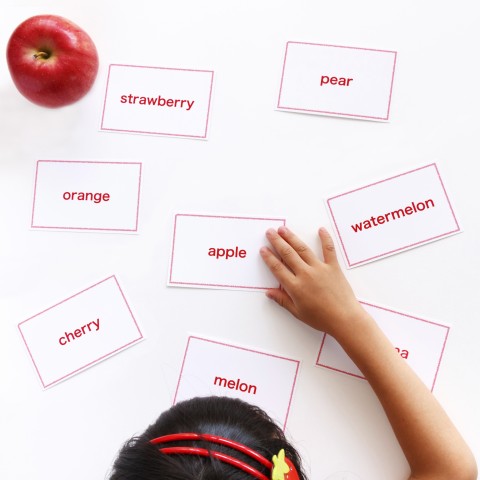
Sitting on the couch can be productive for movie buffs in the present day. Traveling to Vietnam is usually seen as one of the most effective ways to learn the language, but it costs money and time. The good news is: watching movies or feature films is one of the most effective ways to improve your language skills if you apply the right approach. Before jumping to the 10 free Vietnamese movies and feature films online that you can both enjoy and expand your lexicon, here are some tips that might help you throughout the process:
- Pick your favorite Vietnamese film genre: You might probably have had some basic vocabulary for specific topics at this point. Choosing your favorite genre or plot, therefore, will be extremely helpful so that you can really know how to apply it to practical conversations.
- Do not depend on Vietnamese films’ subtitles: Watching a feature film twice is a trick to understanding the plot while learning the language. The first time watching can be either with or without subtitles in your mother tongue, and the second one is the opposite.
- – If you watch Vietnamese movies or feature films with English subtitles (or in your mother tongue) for the first time, you will understand the meaning of the movie immediately. Then turn off subtitles when watching it again and focus on the target language instead the second time. You’ll see that you’ll understand the movie easily even without subtitles because you’ve watched it and now you remember when they’re about to say something. Bear in mind that this is the best time to practice pronunciation by repeating after the characters.
– Not using subtitles the 1st time, on the other hand, allows you to focus on understanding the context without focusing much on exact words. You’ll make your brain work and practice in the target language without depending on the translation. Hence watching the 2nd time is to confirm what you have got so far and clarify what you haven’t understood clearly.
- Take notes: Needless to say that taking notes is significant while watching movies and feature films because this is a chance for you to catch the words and phrases that you haven’t heard before. Try to focus on the ones that you might be using on a daily basis. You’ll be impressed by how it’ll enrich your vocabulary. I used to watch Grey’s Anatomy because I was learning medical English at that time. That was when I learned about “OR – operating room,” “complication,” or other medical terms, and I was so excited that I still remember those words even though I’m not using them often now.
- Enjoy the movie: Learning can be pressuring, and you don’t want to ruin the whole process. Relax and allow yourself to really enjoy the movie sometimes so that you have a chance to listen to the vocabulary listed again and again in the coming episodes.
It’s time to start learning Vietnamese through movies and feature films. Here are some words that I’m going to use while listing the 10 best Vietnamese films. Why don’t we practice a little bit beforehand?
| Cấp độ Level | Khó Difficult | Trung bình Medium | Dễ Easy |
| Phụ đề Subtitles | Tiếng Anh English | Tiếng Việt Vietnamese | Không No subtitles |
| Ngữ điệu Dialect | Miền Nam Southern | Miền Bắc Northern | Miền Trung Central |
| Tốc độ nói Speaking speed | Nhanh Fast | Bình thường Normal | Chậm Slow |
These 10 movies and feature films are not all famous but entertaining and meaningful in their plots. Some of them are for sure very popular and even rated The best movie of the year. I’ll let you explore what you can learn from them, so take a look at the links provided, and you’ll find out what suits you best. Remember, everything is free!
 Table of Contents
Table of Contents
- Bố già (Old father)
- Lan Quế Phường (Lan Kwai Fong)
- Bố trẻ (Young father)
- Phim ngắn (Short movie)
- Phim ngắn|Bạn gái tôi làm gái (My girlfriend is a call girl)
- Mối tình đầu của tôi (My first love)
- Hoa Hồng trên ngực trái (The rose on the left chest)
- Con ghẻ (The adopted child)
- Về nhà đi con (Come home, kids)
- Gạo nếp gạo tẻ (Sticky rice, ordinary rice)
- Conclusion
1. Bố già (Old father)
“Bố già” is a family-love web drama, a 2020 new year comedy project with the ambition to become an international film by Tran Thanh, the most famous Vietnamese host. Tran Thanh is also well known as a comedian, even though he’s not making any romantic comedy. In Bố già, Tran Thanh plays the main role – a brute, conservative but loving father who always cares about his family. The film revolves around the theme of the gangster world, focusing on keeping an honest nature or chasing money. The crew filmed for 11 days. The director is Mr. To – who performed the web drama Thirteen Tam Soi, Thirteen Lady, and Vi Ca prequel… In addition to Le Giang, Tuan Tran, who is very famous for the comedy genre, Tran Thanh’s sister, also played a role. Due to its success in Vietnam for creat, Bố già has been shown abroad as an international film also, and you can watch it on Netflix now. Music is also a very attractive aspect of the film in which Tran Thanh wrote the main song. If you’re curious about Vietnamese music, take a look at one of the newest videos on our Youtube channel talking about the Top 10 Vietnamese popular singers and songs.
- Cấp độ (Level): Khó (Difficult)
- Phụ đề (Subtitles): Tiếng Anh (English)
- Ngữ điệu (Dialect): Miền Nam (Southern)
- Speaking speed (Tốc độ nói): Nhanh (Fast)
- Quote
Tui nói cho ông biết nha (Let me tell you): This is very common for Vietnamese women at their middle age to speak to their husbands. Instead of using Anh – Em to address each other, they often use Ông – Tui/tôi. “Ông” means “grandpa,” but it also means “you,” as now you’re a grandpa.
For example
| Northern style | Southern style | |
| For young couples | Em nói cho anh biết (Let me tell you) | Em nói cho anh biết nha (Let me tell you) |
| For middle age couples who already have grandchildren | Tôi nói cho ông biết (Let me tell you) | Tui nói cho ông biết nha (Let me tell you) |
2. Lan Quế Phường (Lan Kwai Fong)
You probably have heard about Lan Kwai Fong in Hongkong, haven’t you? Don’t expect one if you plan to travel to Vietnam, though. We don’t have a Lan Kwai Fong here, but we have a web-drama, a romantic comedy called the same – Lan Quế Phường.
President’s daughter Ky Thu, famous for her father’s wealth, often hangs out with friends who are badasses in school. One day, her father got revenge and went bankrupt. How can she suffer a poor life, and will she be able to overcome life’s challenges?
The short web drama with a romantic comedy vibe has become super popular for its meaning and modern topic, not to mention all the sexy girls appearing in every scene.
- Cấp độ (Level) : Trung bình (Medium)
- Phụ đề (Subtitles) : Tiếng Anh & Tiếng Việt (English & Vietnamese)
- Ngữ điệu (Dialect) : Miền Nam (Southern)
- Speaking speed (Tốc độ nói) : Bình thường (Normal)
- Quote:
- – Làm tốt nhiệm vụ của mày đi (Do your job well)
– Nếu không tụi bay chết với tao (If not you are dead to me)
– Khách sắp tới (The clients are coming)
3. Bố trẻ (Young father)
“Bố trẻ” is a Vietnamese romantic comedy. In Bố trẻ, Tuan Tran plays a young man named Hoang, a clumsy, arrogant owner of a small riverside bar. Hoang’s life is turned upside down when he is caught in an ironic situation: reluctantly becoming a father of an abandoned baby girl (Ngan Chi). From the initial conflicts, he was forced to accept the situation and adapt to the new role. On the other hand, this also made the father and son Hoang and the people involved also fall into the sights of a gang of gangsters… Let’s take a look at more details in this Vietnamese film.
- Cấp độ (Level) : Vừa (Medium)
- Phụ đề (Subtitles) : Tiếng Anh (English)
- Ngữ điệu (Dialect) : Miền Nam (Southern)
- Speaking speed (Tốc độ nói) : Bình thường (Normal)
- Quote
- – Giờ sao ta (What now?)
– Tôi không phải là ba (I’m not you, dad)
– Con muốn về nhà (I wanna go home)
– Từ nay về sau, em không cần phải làm gì hết. Em chỉ cần làm công chúa của anh thôi (From now on, you don’t have to do anything. You only need to be my princess.)
4. Phim ngắn (Short movie)
Short Vietnamese films are very profitable for producers because of their low cost and high coverage. One of them recently is a short movie about the big family issue – having an affair.
Criticizing his wife for the “smell of milk” after giving birth, the husband went to find another “milk” that was better. The short film is about a man cheating on his wife, who is not young and attractive anymore, with a young beautiful girl and their story afterward.
- Cấp độ (Level) : Trung bình (Medium)
- Phụ đề (Subtitles) : Tiếng Việt (Vietnamese)
- Ngữ điệu (Dialect) : Miền Nam (Southern)
- Speaking speed (Tốc độ nói) : Bình thường (Normal)
- Quote:
- – Nó đi đổ rác thôi nó cũng phải đẹp (She has to be pretty even for taking the garbage out)
– Anh làm chồng làm cha kiểu gì vậy? (What kind of husband, father are you?)
– Cô nhìn lại bản thân mình đi (Look at yourself)
– Cô có xứng đáng với tôi không? (Do you deserve me?)
5. Phim ngắn|Bạn gái tôi làm gái (My girlfriend is a call girl)
Another short Vietnamese film is Bạn gái tôi làm gái (My girlfriend is a call girl). If you travel to Vietnam, it’s very common to see a lot of motorbike taxis on the street. Bạn gái tôi làm gái is a 5-episode web drama talking about a love story of a motorbike taxi driver and a call girl. They both are poor and have to face different challenges in life. However, their ego issues have separated them from each other, and they have to overcome all the difficulties themselves to live their life. Will they be able to forgive and give each other another chance? Although it’s not a typical romantic comedy that young people are obsessed with, Bạn gái tôi làm gái embraces the tough lives of Vietnamese blue-collar workers and will give you emotional moments throughout the film.
- Cấp độ (Level) : Trung bình (Medium)
- Phụ đề (Subtitles) : Tiếng Anh & Việt (English & Vietnamese)
- Ngữ điệu (Dialect) : Miền Nam (Southern)
- Speaking speed (Tốc độ nói) : Bình thường (Normal)
- Quote
– Người ta phải ăn cơm để sống chứ (I have to eat to live)
– Cho anh một cơ hội chăm sóc em (Give me a chance to take care of you)
– Anh thương em, anh thương con người của em (I love you, I love who you are)
6. Mối tình đầu của tôi (My first love)
“Mối tình đầu của tôi” is a Vietnamese film remake of the Korean romantic comedy ‘’She was pretty” – an international film with the participation of Ninh Duong Lan Ngoc, B Tran, Chi Pu, and Binh An who are famous actors and actresses in Vietnam. This is a romantic and funny story about the friendship, love, and work of modern young people. The romantic comedy revolves around the story of close friends An Chi and Ha Linh. While Ha Linh is a beautiful, successful girl, and many boys pursue her, An Chi has an unattractive appearance, is unemployed, and has an outdated style of dress. However, they have had a very beautiful friendship from childhood to the present. Until two “marshal” guys, Nam Phong and Minh Huy appeared and messed up the lives of the two girls. Mối tình đầu của tôi promises many new surprises with the Vietnamese version. You can watch the full Vietnamese drama following this link : Mối tình đầu của tôi
- Cấp độ (Level) : Khó (Difficult)
- Phụ đề (Subtitles) : Không (No)
- Ngữ điệu (Dialect) : Miền Nam & Miền Bắc (Southern & Northern)
- Speaking speed (Tốc độ nói) : Nhanh (Fast)
- Quote
- – Được làm bạn với một người xinh đẹp, giỏi giang và hoàn hảo như An Chi, mình thật là may mắn (To be friend with a beautiful, talented and perfect person like An Chi, I’m so lucky)
– Cho cô một like (I give you a like)
– Tự tin đón chào ngày mới (Confidently welcome a new day)
– Trùng hợp quá ha (What a coincidence)
– Tại sao trên đời này lại có thứ đàn ông đáng ghét như vậy chứ? (Why is there such an abhorrent man in this world)
7. Hoa Hồng trên ngực trái (The rose on the left chest)
In Vietnam, the husband is very powerful in the family. You might not be able to see it easily if you only travel to Vietnam. It’s clearer if you live with a Vietnamese family. “Hoa hồng trên ngực trái” (The rose on the left chest) is a Vietnamese film talking about a multi-dimensional story of family life, the journey of preserving and finding happiness for women in modern society. Khue – Mrs. Hong’s daughter-in-law, like many women who accept to retreat to the rear, only knows about cooking and the story of “diaper, milk” all year. But when she retired to perform her duties as a wife and a mother, Khue was considered useless, a parasite by her husband. Meanwhile, her husband cheated on her with younger, more modern women. You can watch the full series by clicking this link: Hoa hồng trên ngực trái
- Cấp độ (Level) : Khó (Difficult)
- Phụ đề (Subtitles) : Không (No)
- Ngữ điệu (Dialect) : Miền Bắc (Northern)
- Speaking speed (Tốc độ nói) : Bình thường (Normal)
- Quote
- – Cô bị điên à? (Are you crazy?)
– Cứ làm theo những gì chị dặn đi (Just follow what I told you)
– Chuyện của nhà chị cứ để chị tự giải quyết (Let me take care of my family’s business)
– Mình có thể không ly hôn được không anh? (May we not get a divorce?)
8. Con ghẻ (The adopted child)
“Con ghẻ” is a short musical movie published in 2017 and has received over 47 million views on Youtube so far. The movie is set in a poor family context where the parents have to sell their first daughter in order to get money for the husband’s injury treatment. The daughter then became adopted by a rich couple who can’t have kids. After some time, the wife suddenly got pregnant and they happily had their own kid. The adopted girl then became abandoned and got very badly treated by her adoptive parents.
- Cấp độ (Level) : Dễ (Easy)
- Phụ đề (Subtitles) : Tiếng Anh (English)
- Ngữ điệu (Dialect) : Miền Nam (Southern)
- Speaking speed (Tốc độ nói) : Chậm (Slow)
- Quote
- – Tôi qua để hỏi mượn anh ít tiền (I come to borrow some money from you)
– Sao mày dám giành đồ chơi của con tao (How dare you take my baby’s toy?)
– Mày cút ra khỏi nhà tao (Get out of my house)
9. Về nhà đi con (Come home, kids)
The story of the movie “Come home, kids” revolves around 3 sisters Thu Hue, Anh Thu, Anh Duong, who lost their mother at a very young age, each with a different personality and a lifestyle.
The eldest sister Thu Hue is gentle and calm, Anh Thu is beautiful, sharp, and practical while the youngest, Anh Duong, is outspoken, wild, and lives like a son. All three girls have been through their own ups and downs, but they are fortunate to have the same fulcrum, Mr. Son – a devoted father who loves his children wholeheartedly. After many things going on, the 3 daughters all realized that the greatest happiness they have is a father who is always ready to cover and say “Come home, kids” whenever they need a home at the end of the day. You can watch the full Vietnamese series online by clicking this link : Về nhà đi con
- Cấp độ (Level) : Vừa (Medium)
- Phụ đề (Subtitles) : Không (No)
- Ngữ điệu (Dialect) : Miền Bắc (Northern)
- Speaking speed (Tốc độ nói) : Bình thường (Normal)
- Quote
- – Tha thứ cho một kẻ không ra gì không phải vị tha mà là tột đỉnh của sự ngu dốt (Forgiving someone who is worthless is not forgiveness but the culmination of ignorance)
– Không phải sai lầm nào cũng có thể sửa chữa, hối hận nào cũng có thể tha thứ (Not every mistake can be fixed, every regret can be forgiven)
– Nó thừa sức lấy một thằng ít tiền nhưng đạo đức tốt hơn mày (She’s more than capable of marrying a guy with less money but better morals than you)
10. Gạo nếp gạo tẻ (Sticky rice, ordinary rice)
Exploiting a familiar family theme to the Vietnamese audience, Gạo nếp gạo tẻ brings a different color compared to movies in the same genre. The ironic situations in Gạo nếp gạo tẻ stem from the mother’s bias towards her children. Conflicts and differences in behaviors and living situations between the two daughters, one side is loved and spoiled by the mother, the other is despised, have made the relationship between mother-daughter and sisters in the family increasingly difficult and distant from time to time.
- Cấp độ (Level) : Khó (Difficult)
- Phụ đề (Subtitles) : Tiếng Việt (Vietnamese)
- Ngữ điệu (Dialect) : Miền Nam (Southern)
- Speaking speed (Tốc độ nói) : Bình thường (Normal)
- Quote
- – Tôi sinh ra là để được yêu thương chiều chuộng, đây không phải cuộc sống mà tôi mong muốn (I was born to be loved and pampered, this is not the life I want)
–Tôi hối hận vì tôi lấy anh (I regret that I married you)
– Tại sao anh lại bắt tôi suy nghĩ cho người khác vậy chứ. Sống gì mà khổ cực quá vậy? (Why do you make me think for other people? Why do you have to make your life difficult?
– Chỉ cần mình có mục tiêu rõ ràng và quyết tâm thì nhất định sẽ đạt được mục tiêu đó (As long as you have a clear goal and determination, you will definitely achieve it)
– Ép bản thân mình làm chuyện mình không thích thì sẽ khiến cho mình rất mệt mỏi (Forcing yourself to do what you don’t like would exhaust you.)
– Học là để có kiến thức, có kỹ năng. Từ đó mới có thể làm được nghề nghiệp mà mình yêu thích (Learning is to have knowledge and skills. Only then will you be able do the job that you like)
11. Conclusion
Not only can you learn Vietnamese from the movies that I have introduced to you but also from many life experiences from the characters’ lines. I hope that these lines and quotes will inspire you to look for and watch the full movie in your leisure time.
In case you’re still afraid of not knowing where to start, why don’t you visit VietnamesePod101 for more lessons, flashcards, vocabulary lists, and many audio files for better preparation? A free lifetime account is waiting for you and a Youtube channel is also there to support you with pronunciation.
Now, enjoy the movies and I’ll catch you later!

Vietnam’s National Anthem and the Stories Behind it

Most countries have a national anthem with which to express the pride of their country, to convey in it the cultural and historical stories of a nation, to be played on sacred or official occasions, and to represent the noble ideals that all people in the same country aspire to. Most national anthems of countries are public property according to the law. For example, when the American national anthem is performed or recorded during a broadcast of the National Football League (NFL), the NFL will own the reproduction, publishing, and performance rights to this particular show.
Meanwhile, Singapore law stipulates that the national anthem can only be sung or performed on appropriate occasions. Individuals performing or singing the national anthem must perform or sing in accordance with the original or remix that meets strict melody and lyrics requirements.
So, what is a national anthem song?
A national anthem is a song that expresses patriotism, evokes, and celebrates the history, traditions, and struggles of the people of that country, recognized by the government of a country as the official national anthem or widely used by people as a custom.
Whenever there is a flag-raising ceremony at a conference or a sports match between Vietnam and another country, I find that not many national anthems have the same heroic and tragic melody as the Vietnam national anthem, which explains why some consider Vietnam’s national anthem – Tien Quan Ca, by musician Van Cao – one of the most heroic national anthems in the world.
 Table of Contents
Table of Contents
- The first Vietnamese anthem
- Tiến quân ca (The Marching Song Lyric)
- Hoàn cảnh sáng tác Tiến quân ca (the Circumstances of Composing Tien Quan Ca)
- Những dịp hát quốc ca Việt Nam (Singing Occasions for the Vietnamese Anthem)
- Conclusion
1. The first Vietnamese anthem
What is the national anthem of Vietnam?
According to Nguyen Ngoc Huy – a politician of the Republic of Vietnam and a Vietnamese poet and writer – Emperor Bao Dai came down to the stage to select a national flag and anthem during the Second World War. The Vietnamese flag was the Cờ long tinh and the national Vietnamese anthem was the song Đăng đàn cung ( [melody] on the ascent to the esplanade).

Đăng đàn cung is an ancient Vietnamese song and is still used in most of the textbooks teaching classical music and traditional instruments. This is a song from the ritual of Nam Giao sacrifice, used when the king comes to the altar to sacrifice animals and valuable sundries. The Nam Giao sacrifice ceremony, performed every 3 years on the winter solstice, was the most important ceremony in the court’s rites, where the king would make sacrifices on behalf of the nation.
In 1942 in Hanoi, musician Le Huu Muc recorded music and put other lyrics to Đăng đàn cung and called it Vietnam’s national anthem, naming it Tiếng gọi non sông (The Call of the River), also known as Hồn Việt Nam (Vietnamese soul). It was considered by some to be the national anthem, but little was known in the Central region.
| Lời bài hát : Tiếng gọi non sông | The Call of the River Lyric |
| Bên núi sông hùng vĩ trời Nam Đã bao đời vết anh hùng chưa hề tan Vì đâu máu ai ghi ngàn thu? Còn tỏ tường bên núi sông Xác thân tan tành Vì nước quên mình | The majestic mountains and rivers in the South sky For many generations, the traces of heroes have not disappeared Why does people’s blood write for thousands of years? And clearly on the side of the mountain and river Broken body Forgets ourselves for the country |
2. Tiến quân ca (The Marching Song Lyric)
“Tiến quân ca” is a song composed by musician Van Cao in 1944 and has been used as the national anthem of the Socialist Republic of Vietnam since 1976. Before that, “Tiến quân ca” was the national anthem song of the Democratic Republic of Vietnam from 1945 to 1976. Since its birth, the song has been considered the official song of the Viet Minh Front. During the August Revolution of 1945, instead of “Vietnamese troops go,” Viet Minh participants often sang “Viet Minh troops go.” When officially chosen as the Vietnamese national anthem, the lyrics of the national anthem of Vietnam were modified in some ways compared to the original “Tiến quân ca” by Van Cao.
| Vietnam national anthem lyrics in Vietnamese | Vietnam national anthem in English |
| Đoàn quân Việt Nam đi Chung lòng cứu quốc Bước chân dồn vang trên đường gập ghềnh xa Cờ in máu chiến thắng mang hồn nước Súng ngoài xa chen khúc quân hành ca Đường vinh quang xây xác quân thù Thắng gian lao cùng nhau lập chiến khu Vì nhân dân chiến đấu không ngừng Tiến mau ra sa trường Tiến lên, cùng tiến lên Nước non Việt Nam ta vững bền | Soldiers of Vietnam marching onward United in determination to save the nation Our steps resound on the long and arduous road Our flag, red with the blood of victory, bears the spirit of the country The distant rumbling of guns mingles with our marching song The path to glory is built by the bodies of our foes Overcoming all hardships, together we build our resistance bases Let us swear to fight relentlessly for the people’s cause. Let us run to the battlefield! Forward! All together, let’s go forward! The Vietnamese homeland is strong and durable |
| Đoàn quân Việt Nam đi Sao vàng phấp phớiDắt giống nòi quê hương qua nơi lầm than Cùng chung sức phấn đấu xây đời mới Đứng đều lên gông xích ta đập tan Từ bao lâu ta nuốt căm hờn Quyết hy sinh đời ta tươi thắm hơn Vì nhân dân chiến đấu không ngừng Tiến mau ra sa trường Tiến lên! Cùng tiến lên! Nước non Việt Nam ta vững bền | Soldiers of Vietnam marching onward The gold star in the wind Leading our people and our homeland out of misery and suffering Let us unite our efforts in the struggle for building a new life Stand up! With the same impetus, let’s break our irons! For so long we have contained our hatred! Let us be ready to make every sacrifice so that our life may be radiant Let us swear to fight relentlessly for the people’s cause. Let us run to the battlefield! Forward! All together, let’s go forward! The Vietnamese homeland is strong and durable |
3. Hoàn cảnh sáng tác Tiến quân ca (the Circumstances of Composing Tien Quan Ca)
In the 21-year-old Van Cao’s memoirs “Why I wrote Tiến quân ca,” he confided: “The song was made in an unknown number of days in the narrow attic number 45 Nguyen Thuong Hien Street, next to a window overlooking a 2-story house, rows of trees and a gray sky. It often echoes bullock carts carrying bodies of starving people towards Kham Thien Street here. Also, I was sleepless because of the monsoon entering each door, because of the sound of fighting and swearing at each other from a family of poor, undernourished civil servants, echoing through the gaps in the open attic. I understand more life stories here. There are knocks on the door, night calls are unanswered at night.”
After the song was written, Van Cao met and sang it to Mr. Vu Quy, a friend and member of the Viet Minh. Mr. Quy was very pleased. He assigned Van Cao to write the song himself on the printed stone. Because the scribe couldn’t write musical notes, Van Cao had to go directly to a secret printing facility in Bat Trang village to write and print the song “Tiến quân ca” by hand. For the first time, “Tiến quân ca” was printed on the Art page of Doc Lap newspaper in November 1944 with a stone print written by Van Cao himself. Writer Nguyen Dinh Thi, when listening to Van Cao singing this song, was touched and proposed that each of them write another song about the Viet Minh Front. After that, writer Nguyen Dinh Thi wrote the song Diệt phát xít (Destroying the fascists) and Van Cao added the song Chiến sĩ Việt Nam (Vietnamese soldiers), both of which were widely popularized by the public.
- On August 13, 1945, President Ho Chi Minh officially approved “Tiến quân ca” as the national anthem of the Democratic Republic of Vietnam.
- On August 17, 1945, during a meeting of the people of Hanoi in front of the Opera House, the song “Tiến quân ca” was played.
- Also at the Opera House Square, on August 19, 1945, there was the choir of the Young Pioneers singing the song “Tiến quân ca” to salute the national flag during a large meeting.
- On September 2, 1945, “Tiến quân ca” was officially performed on the day of the Declaration of Independence at Ba Dinh Square by the Liberation Army Band led by Dinh Ngoc Lien.

4. Những dịp hát quốc ca Việt Nam (Singing Occasions for the Vietnamese Anthem)
The Vietnamese national anthem, produced by Minh Quan
The national anthem of the Socialist Republic of Vietnam includes the music and lyrics of the song “Tiến quân ca” is often used in flag-raising ceremonies at state offices, schools, political ceremonies of the country, mass organizations, national festivals, or state and national sports events. Quốc thiều is the music of the song “Tiến quân ca/Quốc ca” (Vietnamese anthem song), and is used in flag raising ceremonies, welcome ceremonies for heads of state, state-level ceremonies, and more.
5. Conclusion
No matter what version, Tiến quân ca as the Vietnam national anthem still has a heroic and tragic melody that no one can deny. Learning Vietnamese through songs and movies will not only give you a chance to learn the language but also about our country with a rich history.
If you want to try other Vietnamese cultural lessons, visit VietnamesePod101 for more audio files, flashcards, free lessons, and vocabulary lists to master your Vietnamese today. To improve pronunciation, go to our VietnamesePod101 Youtube Channel for video lessons and free gifts every week.
Want to tell us about your national anthem? Leave a comment below.
Bai!

Everyday Vietnamese Classroom Phrases and Vocabulary

Learning languages starts from lessons in the classroom to traveling, working and living, or learning from the cultures of the country. No matter what strategy of learning, most people find studying from the basics plays an important role in building a sustainable foundation.
When I first studied English, I was also adopting common classroom phrases to understand teachers’ commands. Most of them are actually quite helpful in my actual classes where I later on became a teacher.
If you’re a student learning Vietnamese language, you’re going back to school, or you’re new here and want to improve Vietnamese language learning, I’m here for you. I’m going to share with you several lists of lexicon and Vietnamese classroom words and phrases that you will absolutely use at some point.
First, let’s discover the Vietnamese education system through vocabulary about schools.
 Table of Contents
Table of Contents
- School vocabulary (Từ vựng về trường học)
- School departments Vocabulary (Từ vựng về các phòng ban trong trường)
- Vocabulary about positions in a school (Từ vựng về các vị trí trong trường học)
- Classroom Greetings (Chào hỏi trong lớp)
- Instructions from Teachers
- Teacher’s common teaching techniques
- Student’s common questions/requests
- Explain Absence and Tardiness
- Common questions for students
1. School vocabulary (Từ vựng về trường học)

The Vietnamese education system is not very complicated since we only have a few typical levels of learning and it’s consistent across the country. Public schools’ tuition fees are often more affordable than international or private schools. Here are the most particular school types in Vietnam that you might have heard of to learn vietnamese language.
- Trường dân lập (Private school) : Private schools teaching quality is often slightly lower than public schools due to high costs but low investment and support from the government. However, some families prefer sending their children to private schools for their suitable locations or lower student numbers.
- Trường công lập (Public school) : Public schools are often the most sought after because of their moderate tuition fees and guaranteed teaching quality.
- Trường quốc tế (International school) : There are not many international schools in Vietnam because of the high cost but entering might be easier because it’s for people who can afford the tuition fee.
- Nhà trẻ (Daycare/ Child care center) : Nhà trẻ is for kids between 1-2 years old, some even accept kids from 6-9 months old. Most of them are private establishments because official schools start from preschool which is for kids from 3-5 years old. For some families who don’t have anyone to take care of young kids, they would prefer sending them to local daycares during working hours.
- Trường mầm non/trường mẫu giáo (Preschool) : Trường mẫu giáo accepts students from 3 to 5 years old. Most of the lessons contain games, sing and dance activities and learning numbers or alphabets to prepare for primary school.
- Trường tiểu học/Trường cấp 1 (Elementary school) : Elementary schools are for students from 6 – 10 years old which means there are 5 grades, from grade 1 to grade 5. Most elementary schools don’t require entrance tests but depending on the admissions target of each school, students on the right line will be given priority to enroll first.
- Trường Trung học phổ thông/Trường cấp 2 (Middle school/ Secondary school) : Middle school/ Secondary schools are for students from 11 to 14 years old. They are from grade 6 to 9. Similar to elementary school, entrance tests are not required but study results from elementary school will be considered.
- Trường Trung học cơ sở/Trường cấp 3 (High school) : High school is the most important level of every student because it prepares for university and therefore, specialized schools often require students to take an entrance test. Regular schools may not do so but it takes a lot of effort for parents to choose the right school for their children due to the high demands every year.
- Trường đại học (College/ University) : A bachelor degree is very important to anyone when looking for a job in Vietnam and therefore, entering college/ university is the highest target set for students after 12 years studying at school. The high school graduation exam is used to determine the score for university admission, so this exam is considered extremely important for every student. College/ University usually takes 4 years for general subjects and 5 to 6 years or even more for majors such as medicine and pharmacy.
- Trường cao đẳng (Undergraduate) : If university entrance requirements are often high, undergraduate in Vietnam are a little bit easier to enroll because of lower standards. Undergraduate usually takes 2-3 years.
- Tại chức (Service education/ Service learning) : Service education/ service learning schools are at a lower level than undergraduate or university. It often requires at least 2 years to finish but the degree is not very valuable.
2. School departments Vocabulary (Từ vựng về các phòng ban trong trường)
Technically, these departments are the most common ones in every school in Vietnam. Depending on the specialized disciplines, the departments may differ. Let’s take a look at some vocabulary about school departments in order to prepare for the useful classroom phrases for students and teachers in Vietnamese that I’m going to share with you in the upcoming parts.
- Phòng Học thuật/Phòng Học vụ (Academic Department)
- Phòng Hiệu trưởng (Principal’s office)
- Phòng Hiệu phó (Vice-Principal’s office)
- Phòng y tế ( Nurse’s office)
- Phòng truyền thống (Hall of Fame)
- Văn phòng Đoàn (The youth union room)
- Phòng thí nghiệm (Laboratory)
- Thư viện (Library)
- Giảng đường (Lecture hall)
- Ký túc xá (Hall of resident)
- Phòng bảo vệ (Security section)
- Khu vực gửi xe (Parking space)
- Căng tin (Cafeteria)
- Sân chơi (Playground)

If you’re new to a school and want to ask for directions, here is the sentence structure.
- To friends :
Bạn ơi, làm ơn cho mình hỏi + place + ở đâu? (Hey, may I ask where the + place + is please?)
- To more senior people:
Anh/chị ơi, làm ơn cho em hỏi + place + ở đâu? (Hey, may I ask where the + place + is please?)
- To teachers (if you think they are)
Thưa thầy/cô, làm ơn cho em hỏi + place + ở đâu ạ? (Hey, may I ask where the + place + is please?)
For examples :
- Bạn ơi, làm ơn cho mình hỏi phòng y tế ở đâu? (May I ask where the nurse’s office is please?)
- Chị ơi, làm ơn cho em hỏi thư viện ở đâu? (May I ask where the library is please?)
- Thưa cô, làm ơn cho em hỏi phòng truyền thống ở đâu ạ? (May I ask where the hall of fame is please?)
3. Vocabulary about positions in a school (Từ vựng về các vị trí trong trường học)
Beside your classmates, there will be some positions that you must know when studying at school, for instance:
- Giáo viên (Teacher)
- Giảng viên (Lecturer)
- Trợ giảng (Teaching assistant)
- Giáo viên chủ nhiệm (Head teacher)
- Hiệu phó (Vice-principal)
- Hiệu trưởng (Principal)
- Giáo viên bộ môn (Subject teacher)
- Học sinh (Pupil)
- Sinh viên (Student)
- Bí thư (Secretary)
- Lớp trưởng (Monitor)
- Lớp phó (Vice monitor)
- Bảo vệ (Guard)
- Tạp vụ/Lao công (Janitor)
- Giám thị (Supervisor)
- Nhân viên y tế (Medical officer)
To introduce someone, you can say:
- – Đây là lớp trưởng của lớp tôi (This is my class monitor)
– Kia là giáo viên chủ nhiệm của tôi (That is my head teacher)

4. Classroom Greetings (Chào hỏi trong lớp)
Moving to the main part of the lesson, you wil see that most sentences can be use in Vietnamese reading and writing also. First, let’s explore several basic Vietnamese words and phrases for greeting at school.
- First, let’s see how students greet teachers in Vietnam.
- ➜ Em chào thầy (Hello teacher – For male teacher)
➜ Em chào cô (Hello teacher – For female teacher)
➜ Em chào các thầy ((Hello teacher – For male teachers)
➜ Em chào các cô (Hello teacher – For female teachers)
- ➜ Con chào thầy (Hello teacher – For male teacher)
➜ Con chào cô (Hello teacher – For female teacher)
➜ Con chào các thầy ((Hello teacher – For male teachers)
➜ Con chào các cô (Hello teacher – For female teachers)
Why using this : it sounds closer
Note : it’s more common for young students such as preschoolers or primary students.
- Next, here are ways for teachers to respond to students.
- ➜ Chào em (For old student)
➜ Chào con (For preschooler)
➜ Chào các em (For old students)
➜ Chào các con (For young students)
➜ Cô/Thầy chào các con (For students in general)
➜ Cô/Thầy chào các em (For students in general)
➜ Tôi chào các em (More formal)
- To know how students greet each other, take a look at our video on our Youtube channel How to say Hello or our free article lesson How to say Hello for more details.
5. Instructions from Teachers
You must have noticed somewhere that you can either use “Các em” or “Cả lớp” as “you all” when giving imperatives. In any classroom in the world, there will be different instructions or requirements from teachers for each class. If you are teaching, here are the easiest and most common Vietnamese classroom phrases for teachers that you can use on a daily basis:
- ➜ Các em mở sách trang … (Open your book to page…)
➜ Các em trật tự (Be quiet)
➜ Cả lớp tập trung (Focus)
➜ Bây giờ cô sẽ kiểm tra bài cũ (I’m gonna check the previous lesson now)
➜ Bạn nào chưa làm bài giơ tay (Who hasn’t done your homework please raise your hand)
➜ Hết giờ, cả lớp nộp bài (Time’s up, please submit your assignments)
➜ Hôm nay chúng ta sẽ học về (Today, we’re going to learn …)
➜ Bây giờ chúng ta sẽ làm bài theo nhóm (Now we will work in group)
➜ Cả lớp làm bài tập số ... (Do the exercise number …)
6. Teacher’s common teaching techniques
In some cases, there are some questions to check students’ understanding in a test or at the end of the lesson, or useful classroom phrases in Vietnamese that teachers can apply as teaching techniques.
- To check understanding
- ➜ Câu này là đúng hay sai? (This is correct or incorrect?)
➜ Có ai có câu hỏi gì không? (Does anyone have any questions?)
➜ Các bạn đã nghe rõ đề bài chưa? (Have you heard the title clearly?)
➜ Các bạn đã hiểu rõ đề bài chưa? (Have you understood the title clearly?)
- Correction techniques
- ➜ Có bạn nào có câu trả lời không? (Does anyone have the answers?)
➜ Có bạn nào có đáp án khác không? (Does anyone have another answer?)
➜ Em có chắc không? (Are you sure?)
➜ Có bạn nào có thể giúp bạn được không? (Can anyone help your friend?)
➜ Đây có phải đáp án cuối cùng của em không? (Is this your finalanswer?)
7. Student’s common questions/requests
Education 4.0 encourages students to interact with teachers and their peers anytime in the class for more effectiveness. With teachers who are well trained and equipped with 4.0 teaching methodologies, allowing students to have some free talks in the class is essential to keep students engaged.
Therefore, there are various Vietnamese classroom phrases for students in the classroom:
- For entering the classroom:
- ➜ Thưa cô, cho con vào lớp ạ (Teacher, may I come in the class please?)
➜ Thưa cô, cho em vào lớp ạ (Teacher, may I come in the class please?)
- For better clarity:
- ➜ Thưa cô, con chưa nghe rõ ạ (Teacher, I haven’t heard clearly)
➜ Con có thắc mắc ạ (I have a question)
➜ Em có câu hỏi ạ (I have a question)
➜ Em chưa rõ phần này ạ (I’m not sure about this part yet)
➜ Cô có thể giải thích phần này không ạ? (Can you explain this part?)
➜ Cô có thể nói lại phần này không ạ? (Can you repeat this part?)
➜ Cô chữa bài này được không ạ? (Can you correct this exercise?)

- For adding ideas/comments
- ➜ Con có ý kiến ạ (I have a comment)
➜ Em muốn bổ sung thêm (I’d like to add in some idea)
- For leaving the classroom
- ➜ Thưa cô, cho con ra ngoài ạ (Teacher, may I go out please?)
➜ Thưa cô, đến giờ nghỉ rồi ạ (Teachers, it’s break time)
8. Explain Absence and Tardiness

Everyone would be late or play hooky once in their lives. I’m not an exception.
Let me spill the beans. It was in my highschool. My parents and other students’ were asked to meet my head teacher because the whole class skipped school to hang out the day before.
I had a really good relationship with a fabric shop owner who I’m her regular customer at that time. Because of the parents meeting, I asked her to play as my mom and go meet my teacher.
She agreed!
The day later, she went to my school, acting really cool and apologizing to my teacher as other parents would do. I couldn’t thank her enough.
Break time is over. Let’s get back to the lesson and see what Vietnamese classroom phrases for students that can be used when explaining absence or tardiness.
- ➜ Thưa cô, con bị hỏng xe ạ (My bike is broken)
➜ Thưa cô, con ngủ quên ạ (I overslept)
➜ Thưa cô, hôm nay nhà con có việc, con xin phép nghỉ ạ (I have a family matter to attend today, I would like to take a day off)
➜ Thưa cô, hôm nay con thấy không được khoẻ ạ (I’m not feeling well today)
9. Common questions for students
Last but not least, before checking some useful classroom questions for students, let’s take a look at several words that you can use for the sentence structures afterwards.
- Cái bảng đen (Blackboard)
- Quyển sách (Book)
- Cái ghế tựa (Chair)
- Bàn học sinh (Desk)
- Cái bàn (Table)
- Khăn lau bảng (Duster)
- Cục tẩy (Eraser)
- Quả địa cầu (Globe)
- Sổ ghi chép (Notebook)
- Gọt bút chì (Pencil sharpener)
- Thước kẻ (Ruler)
- Cái bút (Pen)
- Bút chì (Pencil)
- Hộp bút (Pencil Case)
- Sách điện tử (Electric book)
Sentence structure
| Lend me a + thing For example : Mày ơi, cho tao mượn cái bút (Hey you, lend me a pen) |
For example:
- ➜ Cho tao mượn cục tẩy (Lend me an eraser)
- ➜ Cho tao mượn cái thước kẻ (Lend me a ruler)
Other questions:
- ➜ Mày làm bài tập về nhà chưa? (Have you done the homework?)
- ➜ Câu 2 là gì? (What’s the answer for number 2?)
- ➜ Đến nhanh lên, cô chuẩn bị điểm danh (Come quickly, teacher is about to check attendance)
- ➜ em>Mày không đi học à? (You’re not coming?)
- ➜ Mày đưa tao về được không? (Can you give me a ride?)
That’s pretty much for today and I hope it helps.
I’d like to share a little bit more about school etiquettes in another article in the near future.
Although English can be spoken if you’re lucky enough, knowing some basic Vietnamese phrases will help you be more engaged and interact with locals better.Thus, it’s alway worth it to surprise Vietnamese people or your teacher on Vietnamese Teachers’ Day.
For more FREE flashcards, vocabulary lists or audio files if you’re trying to learn Vietnamese language successfully, visit our website VietnamesePod101 and Youtube Channel Learn Vietnamese with VietnamesePod101.com. You can get your free lifetime account for real lessons by real teachers.
Bai!

Vietnamese Vocabulary and Phrases To Use at a Restaurant

Even body language works well when ordering food in Vietnam. Whether it’s a food cart, a street food shop, or a fancy restaurant, basic body language can help you communicate with the seller.
Learning how to speak properly at a restaurant in Vietnam, on the other hand, requires a little bit more effort. You may want to know some useful phrases to use as well as common etiquette in Vietnamese restaurants, especially when you’re not sure what and how to order or they don’t speak English.
Vietnam, fortunately, is an amazing country in terms of food and cooking styles. There are countless types of food throughout the country, and therefore, restaurant types also vary accordingly. In this article, I’m going to introduce to you different Vietnamese restaurant styles, useful vocabulary, numerous Vietnamese phrases to use at a restaurant, and other things you will definitely use as travel guides in Vietnam.
 Table of Contents
Table of Contents
- Các kiểu quán ăn ở Việt Nam (Different Vietnamese restaurant styles)
- Từ vựng về nhà hàng (Restaurant vocabulary)
- Before Dining (Trước khi ăn)
- During Dining (Trong khi ăn)
- After Dining (Sau khi ăn)
- Conclusion
1. Các kiểu quán ăn ở Việt Nam (Different Vietnamese restaurant styles)
A- Đồ ăn đường phố (Street food)
Street food is everywhere in Vietnam, such as Hoi An, Da Nang, Hue, Hochiminh City, Hanoi or Hai Phong. Since street food is super affordable, street food shops, therefore, don’t have a specific style because it all depends on the type of food or the culture of the owner’s family. Lots of street food stalls selling heirloom foods passed down from their grandparents. Hence, it creates a very unique style for each dish that they serve.
Examples (Ví dụ) :
- Hải Phòng rất nổi tiếng với món bánh mì que (Hai Phong is very famous for its breadstick)
- Phở là một món ăn đường phố nổi tiếng ở Việt Nam (Pho is famous street food in Vietnam)
- Mì Quảng là món ăn đặc sản đặc trưng của Đà Nẵng (Quang noodle is a typical specialty dish of Da Nang)
Despite the variety and style, street food is very affordable and can be easily found everywhere. A dish can often cost only 5000 VND, which is less than a dollar. As long as you have from $1 to $3 on hand, you can have a full meal when exploring street food in Vietnam, and it’s one of the things that make Vietnam special.
B- Quán ăn vỉa hè (Sidewalk Eatery)
Food shops on the sidewalk are quite similar to street food shops or stalls in terms of price and style. The main difference is that you have a table and a chair to sit on and it’s very common for most locals since it’s suitable for the living costs.
While street food shops usually serve 1 dish only, food shops on the sidewalk have more choices for you to go with. For example, if you go to a snail shop, there will be plenty of different dishes.
Examples (Ví dụ) :
- Các quán ốc vỉa hè có rất nhiều trong Sài Gòn (There are many sidewalk snail shops in Saigon)
- Đi ăn vặt vỉa hè là một thú vui của người Việt Nam (Snacking on the sidewalk is a hobby of Vietnamese people)
C- Quán ăn/tiệm ăn bình dân (Affordable food shop)
An affordable food shop is a little bit more upscale than a food shop on the sidewalk because there might be staff members to serve you and the service will be better also. Here you can also find more kinds of food from noodles to rice, from chicken to seafood. Many shops serve both Vietnamese food and Western food cooked in Vietnamese style to suit Vietnamese people’s tastes. The price is around $3 – $5, and the portion is also bigger than street food. This kind of shop is suitable for families, a group of friends, or coworkers, and it’s usually busy on weekends. Most of them don’t require a reservation, and you can come anytime.
D- Nhà hàng (Restaurant)
A restaurant is the fanciest type among the four, and it’s usually suitable when you go out on a date, celebrate anniversaries, or organize company events.

In Vietnam, Chinese restaurants, Japanese restaurants, Thai restaurants, and Korean restaurants are probably the most common ones because they’re close to Vietnamese cuisine. In contrast, Western fast food is served in restaurants in Vietnam, but it doesn’t seem to attract Vietnamese people a lot since it contains more fat compared to Vietnamese food, and it’s also more expensive.
Restaurants often don’t require reservations on weekdays but might do on weekends and public holidays due to the high demands. A dish usually costs $5-10, not including 10% tax, but there is no service charge and you can give waiters or waitresses whatever you wish.
2. Từ vựng về nhà hàng (Restaurant vocabulary)
Learning the Vietnamese language is similar to learning Lao or Thai because of the way we put the words together in a sentence.
Before moving to common restaurant phrases, here are some useful vocabulary that you will definitely use at a restaurant in Vietnam.
A- Danh từ (Noun)
- Đồ ăn (Food)
- Đồ uống (Drink)
- Đồ nhậu (Snack for drinking)
- Đồ ăn kèm (Side dish)
- Rau sống (Raw vegetables)
- Món khai vị (Appetizer)
- Món chính (Main dish)
- Món tráng miệng (Dessert)
- Thực đơn (Menu)
- Hoá đơn (Bill)
- Bàn (Table)
- Ghế (Chair)
- Đặt bàn (Reservation)
- Nhân viên phục vụ (Waiter/waitress)
- Khách (Customer)
B- Động từ (Verb)
- Đặt bàn (To make a reservation)
- Đi ăn (To go eating)
- Gọi món (To order)
- Ăn (To eat)
- Uống (To drink)
- Phục vụ (To serve)
- Dọn bàn (To clean the table)
- Thanh toán (To pay)
- Chờ (To wait)
C- Tính từ (adjective)
- Ngon (Good/Delicious)
- Không ngon (Not good/bad)
- Dở tệ (Terrible)
- Nhạt (Bland)
- Mặn (Salty)
- Nhiều dầu (Oily/greasy)
- Khô (Dry)
- Đặc (Thick)
- Loãng (Thin)
- Nhanh (Quick,fast)
- Chậm (Slow)
- Ồn ào (Noisy)
- Đông đúc (Crowded)
- Vắng vẻ/yên tĩnh (Empty/Quiet)
3. Before Dining (Trước khi ăn)
As mentioned above, you don’t need to make a reservation before going to a restaurant in Vietnam unless it’s on weekends or public holidays.
In case you need to make a phone call for a reservation, here is one of the basic Vietnamese phrases to say:
| Cấutrúc (Structure) | Cho (Let/allow) | Chủ ngữ (Subject) | đặt bàn (make a reservation/book) | thời gian (time) |
| Vídụ (Example) | Cho (Let/allow) | tôi (me) | đặt bàn (to book/to reserve a table) | lúc 8h tối nay (at 8PM today) |
Ví dụ:
- Cho tôi đặt bàn lúc 11h trưa nay (I would like to book a table at 11AM today)
- Cho anh đặt bàn ngày mai (I would like to book a table tomorrow)
Besides, there will be some extra questions to make it more specific, here’s how you can respond to those:
- Anh/chị đặt bàn mấy người (How many people will there be?)
Tôi đặt bàn 2 người (I’m booking for 2 people)
- Anh chị có yêu cầu gì đặc biệt không (Do you have any special requests?)
Tôi muốn + yêu cầu (I’d like + request)
Ví dụ: Tôi muốn bàn gần cửa sổ (I’d like a table near the windows.)
- Anh chị có muốn gọi món trước không (Would you like to order in advance?)
Không/Có (No/Yes)
- Anh chị vui lòng gửi xe ở (Please park your vehicle at …) – If the restaurant doesn’t have a parking lot
Anh chị vui lòng tới đúng giờ. Nhà hàng hỗ trợ giữ bàn trong 30 phút (Please arrive on time. We could keep the table for 30 minutes.)
For some reason, you have to cancel the plan. Here’s how you can do so:
- Tôi muốn huỷ đặt bàn hôm nay (I’d like to cancel my reservation today)
Bàn đặt của tôi dưới tên Linh (My reservation is under Linh’s name)
4. During Dining (Trong khi ăn)
This is the main part where you will communicate with the staff directly at the restaurant, from getting their attention to giving feedback after the meal. The sentence structures that I’m going to list down right now are basically the simplest to practice. Let’s get right into them.
A- Getting the waiter’s attention

To call someone coming to your table, the easiest way is to say:
- Em ơi/Anh ơi/Chị ơi
Calling the waiter is not considered rude in Vietnam. Is it on the other hand quite common and easy to get their attention. In case you feel like the restaurant ambiance is a little bit private or quiet, there are several other ways such as:
- Vẫy tay (Wave hand)
- Bấm chuông (Push the bell)
- Giao tiếp bằng mắt (Eye contact)
B- Asking about the menu
- Cho tôi mượn menu (May I have the menu please)
- Ở đây có món gì? (What do you have here?) – In case the food shop doesn’t have a menu
- Em có thể giới thiệu món nào ngon được không? (Can you recommend a few good dishes/ your signature?)
C- Asking about specific things
When coming to a new place that you haven’t been to before, there might be something that you find confused or just simply want to make sure you’re not allergic to. These are a few questions you can ask:
- Món này có cay không? (Is it spicy?)
- Món này cho 2 người có đủ không em? (Is it good for 2 people?)
- Món này không bỏ hành được không? Tôi không ăn được hành (Can you not put onion in this dish? I don’t eat onions)
- Em ơi chị có bàn đặt tên Linh, bạn chị đến chưa? (I have a table under “Linh” name, has my friend come yet?)

D- Ordering
Using the same structure when making a reservation, here is what you can use for ordering food in Vietnam.
| Cấu trúc (Structure) | Cho (Give) | Chủ ngữ (Subject) | số lượng (quantity) | món ăn (dish) |
| Ví dụ (Example) | Cho (Give) | tôi (me) | 2 (two) | phở bò (beef noodle) |
Remember that in this case, “cho” means “give” instead of “allow” or “let” as the one mentioned above although it sounds the same.
Ví dụ:
- Cho chị 2 suất bún chả (Give me 2 portions of bún chả please)
- Cho anh 1 pizza bò (Give me 1 beef pizza please)
E- Asking for utensils
- Cho tôi 1 đôi đũa (Give me a pair of chopsticks please)
- Cho tôi 1 cái thìa (Give me a spoon please)
F- Asking where the bathroom is
- Em ơi, toilet ở đâu? (Where is the bathroom/restroom?)
- Em ơi, chỗ rửa tay ở đâu? (Where can I wash my hands?)
G- Making complaints

- Em ơi, món này mặn quá (This dish is too salty)
- Em ơi, món này không đúng yêu cầu của chị (This dish is not what/ how I wanted it to be)
- Em ơi, chị không gọi món này (I didn’t order this)
- Món này hơi nhạt và nguội (This dish is a bit bland and cold)
- Thịt bò của chị hơi tái, chị muốn chín hơn một chút (My beef is a bit too raw, I want it to be a little more cooked)
H- Giving feedback
At some high-class restaurants, there will be someone coming to ask for feedback after the meal. What they might say is:
- Anh chị thấy đồ ăn hôm nay thế nào? (How do you like the food today?)
And this is how you can say:
- Đồ ăn rất ngon, cảm ơn em (The food is really good, thank you)
- Đồ ăn rất vừa miệng (The food is very tasty)
- Phục vụ hôm nay hơi chậm nhưng đồ ăn rất ngon (Service is a bit slow today but the food is delicious)
5. After Dining (Sau khi ăn)
A- Asking for the bill
- Em ơi, tính tiền cho chị/anh (Please charge me)
- Em ơi, thanh toán cho chị/anh (May I pay please)
B- Payment method
There are options for you to choose whether to pay by cash, credit card or transfer the money directly to the owner. Here is what they will ask:
- Anh chị thanh toán bằng thẻ hay bằng tiền mặt? (Would you like to pay by card or cash?)
And you can say:
- Tôi trả thẻ (I’d like to pay by card)
- Tôi trả tiền (I’d like to pay by cash)
- Tôi muốn chuyển khoản (I’d like to transfer money)
C- Asking for a take away
In case you couldn’t finish the meal and still have a lot on the table, you can ask the waiter to pack the food for you by saying:
- Em ơi, gói giúp chị cái này mang về với (Help me pack this for takeaway, please)
- Em ơi, chị muốn đặt 1 phần mang về (I’d like to order a takeaway)
D- Tipping etiquette
Tipping is not quite common in Vietnam yet because the staff members get paid monthly with or without your tip. Tipping is sometimes even awkward when the restaurant culture doesn’t require it or the staff members are shy to take it.
At regular food shops, the most common way to thank the owner or the staff members is to leave some change from the bill. If you really enjoyed the meal and want to show some appreciation to the waiter or waitress who has done their job well, you can leave some tip on the table before you leave. In that way, it will be comfortable for both. Also, if you want to directly give it to the waiter/waitress, here are several Vietnamese phrases you can use:
- Em có thể giữ lại tiền thừa (You can keep the change)
- Còn lại là của em (The remaining is yours)
6. Conclusion
Exploring the cuisine is one of the most interesting things when traveling to Vietnam or any country. Knowing some basic restaurant phrases to use at the right time is gonna be extremely helpful especially when you want to learn more about the cultures through communicating with locals.
At VietnamesePod101, we will provide you with more basic Vietnamese phrases, vocabulary lists, flashcards and audio files to help you be more confident when learning Vietnamese. Get access to your free lifetime account right now and get your real lessons by real teachers.
Speaking of which, I suddenly feel hungry. Maybe I should go get something to eat right now. I hope you enjoyed reading and see you in the next one.

How to Improve Your Conversation Skills in Vietnamese

Opportunities are typically provided to individuals who are nice and confident. That’s why improving conversation skills allows you to comfortably engage anyone. Conversations should be enjoyable. They entail one-on-one conversations between two or more people regarding a topic of mutual interest.
However, many people are afraid of conducting dialogues. They’re worried that they won’t be able to keep the discussion going or that they just simply don’t know a lot of Vietnamese words and phrases. Wondering how to improve your conversational skills in Vietnamese even when you learn Vietnamese online? These skills can not only be learned and developed but are also surprisingly simple to do so, and we Vietnamese native speakers use them a lot.
 Table of Contents
Table of Contents
- Tone-The Soul of the Vietnamese Language
- Be Friendly and Polite
- Making Yes/No questions
- Create Emotional Connections
1. Tone-The Soul of the Vietnamese Language

In Vietnamese language learning, you’ll notice that Vietnamese is a tonal language. That’s why pronouncing tones correctly is critical because they decide the meaning of Vietnamese words and phrases. Even Vietnamese native speakers have different ways of pronouncing the tones depending on the location. There are six tones in Vietnamese, with five tone marks.
- Thanh Ngang (Mid-Level Tone): no tone mark
- Thanh Huyền (Low Falling Tone):
- Thanh Sắc (High Rising Tone): /
- Thanh Hỏi (Low Rising Tone): ? a question mark without a dot
- Thanh Ngã (High Broken Tone): ~
- Thanh Nặng (Heavy Tone): .
This is an example of a single word with different meanings if it goes with different tones.
- Mai : Tomorrow
Ví dụ :
Mai tôi sẽ nói chuyện kỹ hơn với anh
(I’ll speak to you more clearly tomorrow.)
- Mài : to sharpen
Ví dụ :
Tôi đang mài dao
(I’m sharpening the knife)
- Mái : roof
Ví dụ :
Có một lỗ thủng trên mái
(There’s a hole on the roof)
- Mải : focusing
Ví dụ :
Thằng bé mải chơi game quên cả học bài
(The boy was so focused on playing video games that he forgot to study.)
- Mãi : forever
Ví dụ :
Mong hai bạn mãi hạnh phúc bên nhau
(I hope you two are happy together forever.)
- Khuyến mại : Promotion/sale off
Ví dụ :
Sản phẩm này đang được khuyến mại 20%
(This product is 20% off)
2. Be Friendly and Polite
Don’t you enjoy talking to someone who wholeheartedly shows hospitality and politeness? In addition, it’s very common to see Asian people or Vietnamese native speakers speaking English fluently, but it’s very rare to see a foreigner speaking Vietnamese correctly. That’s why we’re often extremely excited and impressed that someone is learning our language, even if they’re learning Vietnamese online, and it’s absolutely normal to enrich their journey by supporting them. Being friendly and polite to locals is therefore definitely helpful when learning Vietnamese.
There are several ways to say “Hello” and “How are you?” in spoken Vietnamese, and they always work to improve your Vietnamese speaking skills.

- Chào em, chào anh/chị, chào cô/chú/bác, chào ông/bà : Hello
- Ê : Yo/hey (for close friends)
- Lâu rồi không gặp : Long time no see (for someone you haven’t seen for a while)
- Bạn có khỏe không : How are you (for anyone)?
- Khỏe không? : You’re good? (for friends)
- Có gì mới không : What’s up (for friends)?
- Dạo này thế nào rồi? : How have you been? (for friends)
- Ngày hôm nay của bạn thế nào? : How has your day been? (for anyone)
- Rất vui được gặp lại bạn : It’s nice to see you again (for anyone).
Now you can stop saying Xin chào and use any of the Vietnamese words and phrases above to impress Vietnamese native speakers.
3. Making Yes/No questions
Yes/No questions in Vietnamese are super easy to make. Preparing some questions before meeting any Vietnamese native speakers in your mind is a life changer. There was a time when I was hanging out with some foreign friends, and my English wasn’t really good at the moment because I was learning Vietnamese online. I still remember that, besides actively listening to what they were saying, I would focus on the topic to formulate some questions to clarify or ask for more information. The conversations always went well.
What Yes/No looks like in Vietnamese :
- Có, ừ, vâng, dạ, rồi (Yes) “Vâng/ dạ” is used when talking to older people, whereas “Có/ ừ/ rồi” is for friends.
- Không, chưa (No)
In your Vietnamese language learning journey, remember that if you want to show respect to older Vietnamese native speakers, always add “ạ” at the end of the sentence when speaking. Writing, on the other hand, doesn’t require “ạ” all the time as it’s considered redundant.

Now let’s see how many types of Yes/No questions there are in the Vietnamese language. The tip is to remember a few key Vietnamese words and phrases below.
– Tag questions : questions that end with “à/phải không/đúng không”
Ví dụ:
- Bạn là học sinh mới à? (Are you a new student?)
Ừ (Yes): For friends
Không (No)
- Em là học sinh à? (Are you a new student?)
Vâng ạ (Yes): For older people
Không ạ (No)
- Bạn học tiếng Việt ở trên mạng đúng không? (Did you learn Vietnamese on the internet?)
Ừ (Yes): For friends
Không (No)
– Questions that have có + động từ (verb) + không? (Do you …)
Ví dụ:
- Bạn có laptop không? (Do you have a laptop?)
Có (Yes)
Không (No)
- Bạn có thích đi du lịch không? (Do you like travelling?)
Có (Yes)
Không (No)
- Bạn có lái xe không? (Do you drive?)
Có (Yes)
Không (No)
– Questions that end with “chưa”: questions in the Present perfect tense.
In this case, instead of saying “Không” for “No,” remember that we always use “Chưa” instead, unless you don’t plan to do it at all.
- Bạn đã ăn cơm chưa? (Have you eaten)
Rồi (Yes): meaning you have eaten.
Chưa (No): meaning you haven’t eaten.
Không ăn (No): meaning you plan to skip.
4. Create Emotional Connections
Telling stories or putting away distractions are some of the most effective ways to show respect to Vietnamese native speakers, create deeper connections, and improve conversation skills. Let’s practice this technique in your Vietnamese language learning journey by breaking it down into small techniques as below:
– Khen ngợi: Giving compliments
A thoughtful and kind compliment can make someone’s day. Here are some examples that you can immediately use with any native Vietnamese speaker in your Vietnamese language learning journey.
- Em làm tốt lắm: You did a good job (For younger people)
- Anh/chị nhiệt tình quá: You’re very enthusiastic.
- Cảm ơn anh/chị đã mời em ăn tối: Thank you for dinner.
- Màu này hợp với anh/em lắm : This color suits you a lot.
- Hôm nay em rất đẹp: You look beautiful today (for women)
- Anh/chị dùng nước hoa gì thế? What perfume are you wearing?
- Đợt này nhìn da chị thích thế? Your skin looks really nice lately.
- Con bé nhà anh/chị học giỏi thật đấy : Your child is doing really well in school.
If you want to practice pronunciation too when you learn Vietnamese online, follow my instructions by clicking here for more details.

– Sử dụng thán từ : Using Exclamations
“Thán từ” are Vietnamese words and phrases used to emphasize your feelings and develop your Vietnamese conversation skills, which are not often mentioned when you learn Vietnamese online. Although it’s a little bit challenging for learners to naturally apply them in conversations in Vietnamese at first, it’s always fun to experiment and see how native speakers react to your efforts, isn’t it?
- Thật á (Really): To show surprise/fear
Ví dụ :
- Tao bị giật điện thoại rồi (My phone was stolen)
Thật á? (Really?)
- Ôi giời ơi (Oh my god): To show surprise/fear
Ví dụ :
- Ôi giời ơi, mày làm tao giật cả mình (Oh my God, you scared me)
- Cái gì (What): To ask for repetition
Ví dụ :
- Đi ăn không? (Wanna go grab something to eat?)
Cái gì? (What?)
- Làm sao (What?): To tease someone or to ask for clarification
Ví dụ :
- Bật nhỏ tivi thôi! (Turn down the TV)
Làm sao? (What?)
- Vãi (What the): To show surprise/fear
Ví dụ :
- Con nhỏ đó cặp với ông kia lớn tuổi lắm (That girl is dating a very old man).
Vãi… (What the …)
- Ôi/Uầy (Oh my): To show surprise/fear
Ví dụ :
- Macbook Pro bây giờ hơn 40 triệu mày ạ (MacBook Pro now is over 40 million)
Uầy, chát nhờ… (Oh my, it cost an arm and a leg…)
- Thôi xong (Crap): To show surprise/fear
Ví dụ :
- Mai kiểm tra một tiết nhé (There’s a 45-minute test tomorrow).
Thôi xong! (Crap!)
- Ôi mẹ ơi : Oh mama : To show surprise/fear
Ví dụ :
- Sẽ hơi đau một chút đó (It’s going to be a little painful)
Ôi mẹ ơi (Oh mama)
- Không!!! (Oh no): To show surprise
Ví dụ :
- Sáng mai dậy sớm nhé (Let’s wake up early tomorrow)
Không!!! (Oh no!!!)
- Điên à (Are you crazy?): To show surprise
Ví dụ :
- Cho tao vay 100 triệu đi sửa mũi (Lend me 100 million to get my nose job)
Điên à? (Are you crazy?)
- Hoan hô (Bravo): To celebrate something
Ví dụ :
- Em tao đỗ đại học rồi (My sister got into college)
Hoan hô!!! (Bravo!!!)
- Thông minh (Brilliant): To recognize someone’s great idea
Ví dụ :
- Cách này nhanh hơn đấy (This way is faster)
Thông minh! (Brilliant!)

– Sử dụng các từ đệm : Using Filler words
Filler words can sometimes be frustrating for listeners if they’re overused. However, it can be a great tool to buy time or think of what to say next, especially when learning Vietnamese, which is not mentioned much when you learn Vietnamese online. Using filler words can be easy if you remember these tips.
First, don’t try to add filler Vietnamese words and phrases to every sentence. It can be an overwhelming conversation in Vietnamese. Instead, speaking slowly and smoothly will help improve your fluency while giving you some time to catch up with the tones.
Second, use your facial expressions or adjust your tone to emphasize the main idea of your speech, not the filler Vietnamese words and phrases. It will distract people from focusing on your hesitance instead.
Lastly, repeat the questions or the sentences once you don’t completely understand the meaning. Vietnamese people are very friendly, and we’re always willing to support you if you need it.
By the way, here are some filler words [youtube video] that are commonly used with examples:
- Kiểu như là, hay là, hoặc là : it’s like/or
Ví dụ:
- Hôm qua anh ấy nói chuyện với tôi kiểu như là có gì đó khó nói lắm.
(He talked to me yesterday as if it was like there was something difficult to tell.)
- Hiểu không? : got it?
Ví dụ:
- Ý tôi là chúng ta cần phải bàn kỹ hơn việc này, hiểu không?
(What I mean is we need to discuss it more carefully, get it?)
- Đúng không? : right?
Ví dụ:
- Em đang làm việc. Anh cứ nhắn tin làm sao em tập trung được, đúng không?
(I’m working. How can I focus if you keep texting me, right?)
- Nói chung là : basically
Ví dụ :
- Anh phải xem lại bản kế hoạch đã rồi mới trả lời em được. Nói chung đợt này anh bận lắm.
(I have to double-check the plan, then I can answer you. Basically, I’ve been busy lately)
- Là, thì : so, then
Ví dụ :
- Tóm lại (là), chúng ta cần phải thanh toán hết cho họ.
To sum up, we need to pay them off.
- Xong rồi : and then
Ví dụ :
- Em ăn đã, xong rồi em sẽ gọi lại cho anh
I’m eating, then I’ll call you later.
No matter how many Vietnamese words and phrases you know, it doesn’t make any sense if you don’t have conversations in Vietnamese every day and really own them. Vietnamese is, interestingly, a highly customizable language. What I mean is, that even pronouns or verbs can be reduced sometimes, and it’s still understandable. Are you curious how so? Keep in touch, and I’ll tell you in future blogs.
Don’t forget to visit VietnamesePod101.com often for a better experience and to improve your conversation in Vietnamese. We provide plenty of audio lessons and vocabulary lists to enrich your lexicon.
Enjoy learning!

Vietnamese Conversation Starters for Deeper Connections

Why keep saying “Xin chào” to Vietnamese native speakers when there are countless ways to start a conversation? Strangers are everywhere no matter if you’re at a party, on the first day at work, or on a first date. Starting a conversation can be scary sometimes, especially with introverts and Vietnamese people. It sounds weird but true. Vietnamese native speakers tend to be shy and less active when talking to new people.
However, no need to bother whether you’re an absolute beginner or an intermediate, in the Vietnamese language learning framework, Vietnamese conversation starters can be easier to apply than you thought.
Needless to say that choosing the right personal pronoun to address people is a must in Vietnamese language learning. Interestingly, Vietnamese native speakers start talking by guessing how old the other person is so that they can call them properly. This shows the diversity of the Vietnamese language compared to others. More importantly, using the right tone is useful in this case to help you avoid awkwardness. Don’t panic! We have the list of conversation starters in Vietnamese language learning broken down by the 4 most common situations where you can comfortably start a conversation without hesitance. Ready? Keep reading!
 Table of Contents
Table of Contents
- You’re Single and Ready to Mingle!
- Conversation Starters for Socializing
- Conversation Starters for First Day at Work
- Conversation Starters to Reconnect with a Friend through Text or Email
- Conclusion
1. You’re Single and Ready to Mingle!

The truth is, talking about yourself too much on the first date is considered impolite in Vietnam sometimes. Instead, Vietnamese native speakers preferred to be listened to and received compliments. Then what to ask on the first date without being rude when learning Vietnamese? Here are some examples for your Vietnamese speaking exercises:
- Công việc của em/anh thế nào? (How’s your job?/What’s your job like?)
Asking about someone’s work is one of the safest Vietnamese conversation topics when starting a conversation in Vietnam. We all spend 8 hours per day working. Thus, no need to worry at all when asking “Công việc của em/anh thế nào?” because it’s quite comfortable to share some typical things at the office that we do every day.
Another version for it when learning Vietnamese can be :
- Bình thường ở công ty công việc chính của em/anh là gì? (Normally what are your main duties at the company?)
Once the person is willing to share about their job, he/she will probably want to talk about more personal Vietnamese conversation topics such as family. The next opening questions could be:
- Gia đình em/anh như thế nào? (How is your family?/What is your family like?)
- Em/Anh kể về gia đình anh/em đi (Tell me about your family)
- Em/anh có anh chị em gì không? (Do you have any siblings?)
- Anh/chị em/anh làm gì? (What does your brother/sister do?)
The technique here is to ask questions that end with “thế nào” (how) or “gì”(what) so that the person has a chance to talk more than just saying Yes or No. Forget about “Em tên là gì” (What’s your name?) or “Em bao nhiêu tuổi” (How old are you?). They’re boring. Instead, get to the point, and you’ll be surprised that it works better than traditional ways of Vietnamese language learning. Cooking can also be a nice Vietnamese conversation topic to talk to Vietnamese women about, who doesn’t enjoy eating and cooking?

Now, bear in mind that compliments always work. But how do you make your compliments sound sincere and less fake? Take a look at this one when learning Vietnamese:
- Em dùng nước hoa gì vậy, anh thích mùi này (What perfume are you wearing? I like this scent)
Vietnamese native speakers would love to hear that someone likes their scent, no matter if they’re wearing cologne or not. Please note that a nice scent can come from clothes, hair, or oil also. Showing that you care about little things is a great way to show affection towards the person, especially for women. No matter where you are or who you’re talking to, starting a conversation with a compliment is always the best. Don’t forget to practice your Vietnamese speaking exercises with this kind of sentence.
Men, on the other hand, are slightly different. Things like watches, shirts, or shoes are ways for them to show their style. Therefore, a simple compliment can make their day:
- Anh đeo đồng hồ hợp lắm (You look good wearing a watch)
Once a Vietnamese man wears a watch, he loves watches, and nothing sounds better than knowing his style is appreciated. Your conversation can start smoother than ever. Note that when learning Vietnamese!
Other examples that will also work:
- Em mặc váy trông rất hợp (Dresses suit you a lot)
- Em có đôi mắt rất đẹp (You have very beautiful eyes)
- Công việc của anh thú vị ghê (Your job sounds very interesting)
What not to say on the first date
We’re not done yet. You don’t want to sound rude on the first date by talking about Vietnamese conversation-sensitive topics. Here are a few things that you may want to avoid when learning Vietnamese. In case the date is already a disaster, this happens to be helpful for you to get out of it.
- Lương của em một tháng được bao nhiêu? (How much is your salary?)
A guy asked me on our first date how much I made per month when we were at the cinema. Apparently, I’ve never seen him ever since. It’s not about the question, it’s about the intention of wanting to know how much a woman makes on the first meeting. It would make more sense if it was the tenth date. Nevertheless, asking about someone’s financial status is not a good idea at all if you don’t want to ruin your conversation.
- Em có biết tại sao Việt Nam lại có cả thủ tướng và chủ tịch nước không? (Do you know why Vietnam has both a prime minister and a president?)
Talking about politics is not that bad if the person is familiar with it. In case he or she is not a big fan of politics, your conversation can be boring, and it will come to an end. Furthermore, changing the topic can be tricky at this point. Therefore, try to avoid politics unless you clearly know your partner is interested.
- Em yêu mấy người rồi? (How many guys were you in a relationship with?)
This is a disaster. Personal relationship status is a big deal in Vietnam. Even if someone is comfortable sharing it, it’s a terrible idea to ask such a question on the first date. There is a rumor that Vietnamese girls usually say three when being asked this question. Wondering why? Two is a bit too little, and four is a little too many. Three, therefore, is a suitable number. God knows how many they actually dated.
- Không trang điểm trông em xin hơn đấy (You look better without makeup)
When you’re dating already, this means a lot to Vietnamese women because not everyone knows how to do makeup. Saying she looks better without makeup is highly appreciated because you’re saying she’s naturally beautiful. HOWEVER, saying that someone looks better without makeup on the first date in Vietnam indicates that she looks terrible with her makeup on, which is very rude to say to be honest. Now you know why! Again, remember not to use this type of sentence in your Vietnamese speaking exercises.
Relax! Let’s move on to the second situation, where I’ll show you detailed steps from the beginning to the end of a conversation in Vietnamese language learning.
2. Conversation Starters for Socializing

When learning Vietnamese, these 5 steps are typical techniques to connect with someone for the first time, whether you’re at a party, a social event, or even at a club. Remember that follow-up questions are highly recommended to extend the conversation and have more ideas for the next Vietnamese conversation topics. The good news is that slang terms can be used in this case to impress people. Now, let’s start with the very first step of Vietnamese language learning – Greetings, the basic one.
Step 1: Greetings
- Chào em/Chào anh (Hi)
- Anh tên là/Em tên là (I’m [name])
Instead of saying Xin chào (Hello), Chào anh/em sounds closer and friendlier. In addition, using Anh – Em is a great way to start a conversation because it’s common to address each other Anh – Em in a relationship. You have just shortened the distance by using 2 simple words.
Also, greeting does not mean you have to say “Hi” all the time. Remember the “get to the point” technique above? Here are some examples:
- Hôm nay nhạc chơi hay nhỉ (The music today is nice, isn’t it?) – At a club or a party
- Đồ uống ở đây pha ngon (Drinks are made well here)
- Em đi với bạn hay đi một mình (Do you come with friends or you’re here alone?)
Step 2: Asking for more information
- Em/anh đến đây lâu chưa?(How long have you been here?)
- Em/anh học/làm ở đâu? (Where do you study/work?)
- Em/anh có hay đến đây chơi không? (Do you often hang out here?)
Step 3: Asking about common hobbies
- Lúc rảnh anh/em thích làm gì? (What do you like to do in your free time?)
- Em/anh thích ăn gì? (What do you like to eat/what’s your favorite food?)
- Em/anh có thích … không? (Do you like + examples?)
Step 4: Making an appointment using Let’s structure in Vietnamese.
- Tuần sau em/anh có rảnh không? (Are you free next week?), đi xem phim đi (let’s go watch movies)
- Hôm nào em/anh rảnh? (When are you available?)
- Anh có thể mời em đi uống cà phê được không? (May I invite you out for coffee sometime?)
Step 5: Asking for contact
- Em/anh có dùng Zalo không? (Do you use Zalo?)
- Em có dùng + [mạng xã hội] không? (Do you use any + [social network])?
Besides, knowing basic etiquette in Vietnam will also get you on the way to becoming more familiar with anyone you talk to for the first time when learning Vietnamese. It shows how much you care about the cultures as well as the people and this is an exact approach. Don’t forget to practice your Vietnamese speaking exercises with this kind of sentence.
3. Conversation Starters for First Day at Work

On the other hand, talking at work requires higher techniques in some other situations when learning Vietnamese. Asking too many questions on the first day at work might be considered bad manners or a sign of inexperience in Vietnam. Instead, making smart questions and spending time to self-study before asking is a good way to remember things and get to know the job. Instead of asking only, people can make requests, and use How or multiple-choice questions when learning Vietnamese. Details are as follows:
Example 1: Asking where something is by making requests
- Anh chỉ giúp em phòng Marketing với ạ (Please show me the Marketing Department)
- Chị đi cùng em lên phòng điều hành nhé (Please go with me to the Operations Department)
- Phòng Kế toán ở tầng 3 hay tầng 4 ý nhỉ (Is the Accounting Department on the 3rd or 4th floor?)
- Anh share giúp em thư mục … nhé (Please share with me the … folder)
Example 2: Making How questions
- Bình thường anh lưu trữ tài liệu thế nào ạ? (How do you often store documents?)
- Quy trình xin hoá đơn bên công ty mình như thế nào ạ? (What is the process of applying for invoicing in our company like?)
- Chị lên lịch dự án như thế nào ạ? (How do you schedule projects?)
Example 3: Using multiple choice questions by asking for specific cultures
- Mọi người hay mang cơm hay là ra ngoài ăn trưa? (Do you usually bring food or go out for lunch?)
- Ngày nghỉ mọi người thường hay đi ăn hay tối hay là đi cà phê? (Do you usually go out for dinner or drink coffee on your days off?)
- Phòng mình có hay uống trà sữa không? (Do you often drink milk tea?)
Another technique that might help when starting conversations when learning Vietnamese is to show interest by using exclamations. Remember that the little things matter, especially for conversation starters in Vietnamese.
Besides, do you know that Vietnamese native speakers are religious sometimes? Knowing someone’s age and the 12 Zodiac animals is an interesting tool. We’ll have a bunch of things to talk about the 12 Zodiac animals in another blog.
4. Conversation Starters to Reconnect with a Friend through Text or Email
Starting a conversation after a long time with someone can be awkward. Vietnamese native speakers sometimes call very old friends to invite them to their wedding or even… borrow money. How to start a conversation in this case without reluctance for both? These are some common questions in Vietnamese language learning to reconnect with someone you haven’t seen for a while.

Common questions :
- Khoẻ không? (Are you doing well?)
- Dạo này thế nào rồi (How have you been doing lately?)
- Có gì mới không (Anything new?)
- Công việc dạo này thế nào rồi? (How has your work been?)
- Sắp tới có dự định gì không? (Do you have any plans in the near future?)
Here are some extra questions if you want to be more specific
- Em bé dạo này ngoan không? (Is the baby good these days?)
- Công việc của ông xã thế nào rồi? (How is your husband’s work)
- Ba mẹ bạn khoẻ không? (Are your parents doing okay?)
5. Conclusion
Once you both could feel the vibe, it is easier to move on to another Vietnamese conversation topic. Think of all the common things you’ve had together and naturally share your thoughts or reasons for why you haven’t connected for a while. Most people you have a good relationship with will also quickly get involved in the conversations.
Mindful conversation starters are best for deepening relationships and encouraging meaningful talks, whether with newcomers, family members, or friends. What are some of your favorite questions to ask or answer? Share them in the comment below and visit VietnamesePod101.com for more learning materials.

Vietnamese Keyboard: How to Install and Type in Vietnamese
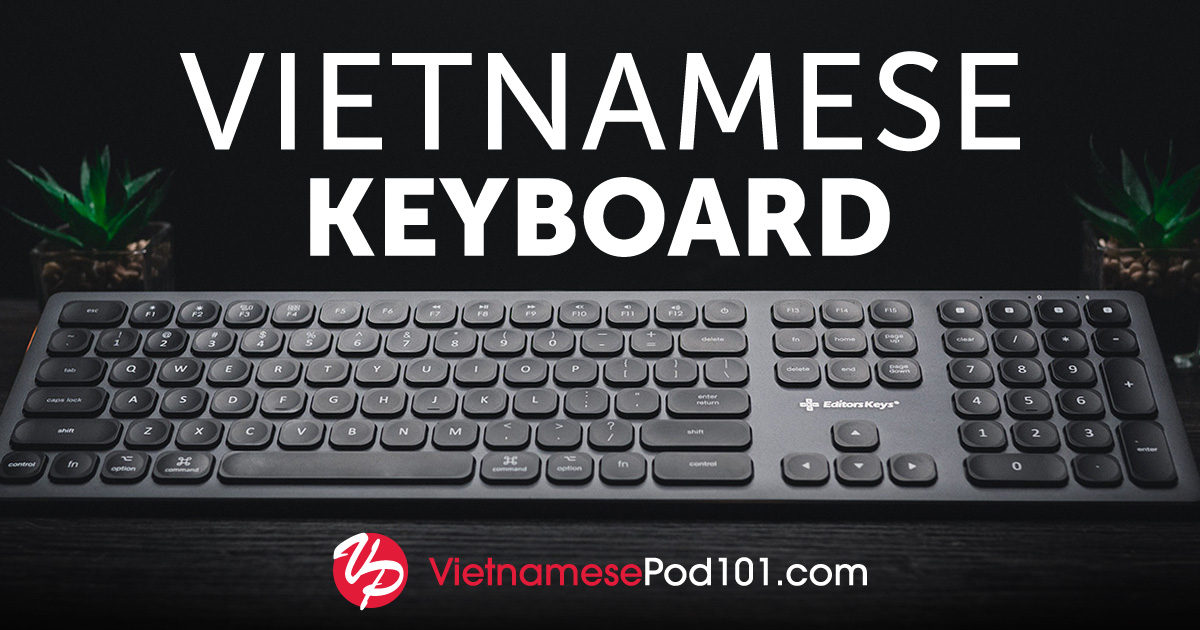
You asked, so we provided—easy-to-follow instructions on how to set up your electronic devices to write in Vietnamese! We’ll also give you a few excellent tips on how to use this keyboard, as well as some online and app alternatives if you prefer not to set up a Vietnamese keyboard.
 Table of Contents
Table of Contents- Why it’s Important to Learn to Type in Vietnamese
- Setting up Your Computer and Mobile Devices for Vietnamese
- How to Activate an Onscreen Keyboard on Your Computer
- How to Change the Language Settings to Vietnamese on Your Computer
- Activating the Vietnamese Keyboard on Your Mobile Phone and Tablet
- Vietnamese Keyboard Typing Tips
- How to Practice Typing Vietnamese
1. Why it’s Important to Learn to Type in Vietnamese

Learning a new language is made so much easier when you’re able to read and write/type it. This way, you will:
- Get the most out of any dictionary and Vietnamese language apps on your devices
- Expand your ability to find Vietnamese websites and use the various search engines
- Be able to communicate much better online with your Vietnamese teachers and friends, and look super cool in the process!
2. Setting up Your Computer and Mobile Devices for Vietnamese
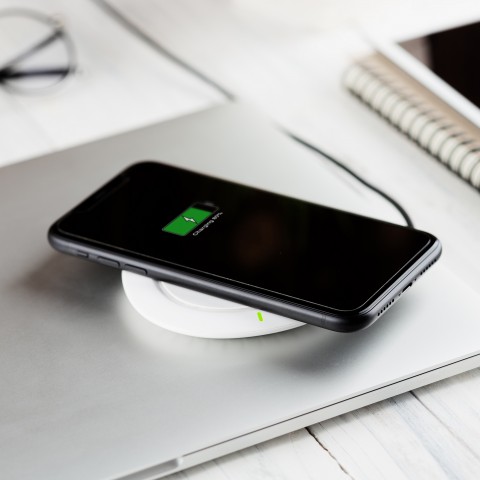
It takes only a few steps to set up any of your devices to read and type in Vietnamese. It’s super-easy on your mobile phone and tablet, and a simple process on your computer.
On your computer, you’ll first activate the onscreen keyboard to work with. You’ll only be using your mouse or touchpad/pointer for this keyboard. Then, you’ll need to change the language setting to Vietnamese, so all text will appear in Vietnamese. You could also opt to use online keyboards instead. Read on for the links!
On your mobile devices, it’s even easier—you only have to change the keyboard. We also provide a few alternatives in the form of online keyboards and downloadable apps.
3. How to Activate an Onscreen Keyboard on Your Computer
1- Mac
1. Go to System Preferences > Keyboard.
2. Check the option “Show Keyboard & Character Viewers in Menu Bar.”
3. You’ll see a new icon on the right side of the main bar; click on it and select “Show Keyboard Viewer.”

2- Windows
1. Go to Start > Settings > Easy Access > Keyboard.
2. Turn on the option for “Onscreen Keyboard.”
3- Online Keyboards
If you don’t want to activate your computer’s onscreen keyboard, you also have the option to use online keyboards. Here are some good options:
4- Add-ons of Extensions for Browsers
Instead of an online keyboard, you could also choose to download a Google extension to your browser for a language input tool. The Google Input Tools extension allows users to use input tools in Chrome web pages, for example.
4. How to Change the Language Settings to Vietnamese on Your Computer

Now that you’re all set to work with an onscreen keyboard on your computer, it’s time to download the Vietnamese language pack for your operating system of choice:
- Windows 8 (and higher)
- Windows 7
- Mac (OS X and higher)
1- Windows 8 (and higher)
- Go to “Settings” > “Change PC Settings” > “Time & Language” > “Region & Language.”
- Click on “Add a Language” and select “Vietnamese.” This will add it to your list of languages. It will appear as Tiếng Việt with the note “language pack available.”
- Click on “Tiếng Việt” > “Options” > “Download.” It’ll take a few minutes to download and install the language pack.
- As a keyboard layout, you’ll only need the one marked as “Vietnamese – Tiếng Việt.” You can ignore other keyboard layouts.
2- Windows 7
- Go to “Start” > “Control Panel” > “Clock, Language, and Region.”
- On the “Region and Language” option, click on “Change Keyboards or Other Input Methods.”
- On the “Keyboards and Languages” tab, click on “Change Keyboards” > “Add” > “Vietnamese.”
- Expand the option of “Vietnamese” and then expand the option “Keyboard.” Select the keyboard layout marked as “Vietnamese.” You can ignore other keyboard layouts. Click “OK” and then “Apply.”
3- Mac (OS X and higher)
If you can’t see the language listed, please make sure to select the right option from System Preferences > Language and Region
1. From the Apple Menu (top left corner of the screen) go to System Preferences > Keyboard.
2. Click the Input Sources tab and a list of available keyboards and input methods will appear.
3. Click on the plus button, select “Vietnamese,” and add the “Vietnamese” keyboard.
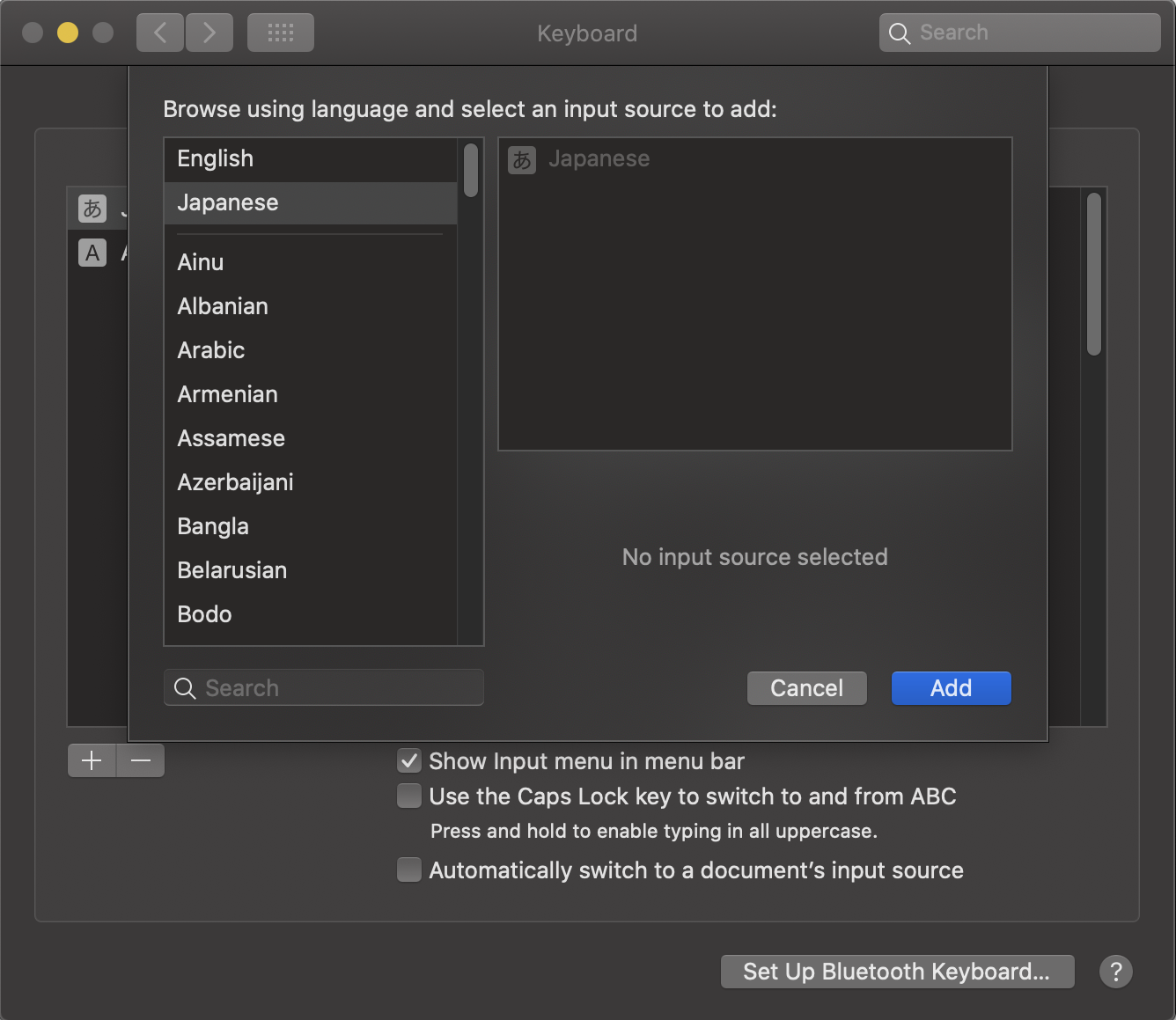
5. Activating the Vietnamese Keyboard on Your Mobile Phone and Tablet
Texting and searching in Vietnamese will greatly help you master the language! Adding a Vietnamese keyboard on your mobile phone and/or tablet is super-easy.
You could also opt to download an app instead of adding a keyboard. Read on for our suggestions.
Below are the instructions for both iOS and Android mobile phones and tablets.
1- iOS
1. Go to Settings > General > Keyboard.
2. Tap “Keyboards” and then “Add New Keyboard.”
3. Select “Vietnamese” from the list.
4. When typing, you can switch between languages by tapping and holding on the icon to reveal the keyboard language menu.
2- Android
1. Go to Settings > General Management > Language and Input > On-screen Keyboard (or “Virtual Keyboard” on some devices) > Samsung Keyboard.
2. Tap “Language and Types” or “ + Select Input Languages” depending on the device and then “MANAGE INPUT LANGUAGES” if available.
3. Select “Tiếng Việt” from the list.
4. When typing, you can switch between languages by swiping the space bar.
3- Applications for Mobile Phones
If you don’t want to add a keyboard on your mobile phone or tablet, these are a few good apps to consider:
6. Vietnamese Keyboard Typing Tips
Typing in Vietnamese can be very challenging at first! Therefore, we added here a few useful tips to make it easier to use your Vietnamese keyboard.

1- Computer
In Windows Keyboard
1. To add an accent mark over a vowel (â, ă, ê, ô, ơ, ư), type the following: a + w = ă; a + a = â; e + e = ê; o + o = ô; o + w = ơ; u + w = ư.
2. To add diaeresis over a vowel (à, á, ả, ã, ạ) type the following: : a + f = à; a + s = á; a + r = ả; a + x = ã; a + j = ạ.
In IOS Keyboard
1. To add an accent mark over a vowel (â, ă, ê, ô, ơ, ư), type the following: a + 8 = ă; a + 6 = â; e + 6 = ê; o + 6 = ô; o + 7 = ơ; u + 7 = ư.
2. To add diaeresis over a vowel (à, á, ả, ã, ạ) type the following: a + 1 = á; a + 2 = à; a + 3 = ả; a + 4 = ã; a + 5 = ạ.
2- Mobile Phones
1. On iOS mobile devices, hold the vowel key and select the type of accentuation from the menu that pops up.
2. In the Android Keyboard system, characters are selected from the base character dropdown (or double clicking) and diacritics have their own key.
7. How to Practice Typing Vietnamese
As you probably know by now, learning Vietnamese is all about practice, practice, and more practice! Strengthen your Vietnamese typing skills by writing comments on any of our lesson pages, and our teacher will answer. If you’re a VietnamesePod101 Premium PLUS member, you can directly text our teacher via the My Teacher app—use your Vietnamese keyboard to do this!

Vietnamese Women’s Day – An Ode to Progress

Vietnam’s perception of women has had a long history. From before the start of China’s rule over Vietnam—when the country is thought to have been matriarchal—all the way through its European rule, the Vietnam War, and everything in-between, society’s view of women has undergone many shifts, not all of them positive.
Today, however, the role of Vietnamese women in society is much stronger than in times past. This progress, and the lời chúc mừng (“wish”) for future progress, is expressed each year through Vietnamese Women’s Day.
In this article, you’ll learn more about the history of this holiday, how the Vietnamese celebrate it today, and more.
Let’s get started!

1. What is Women’s Day?

Each year on October 20, Vietnamese Women’s Day is welcomed with open arms.
This is a holiday dedicated to honoring and respecting women, fighting for their rights, and reflecting on how far gender equality in Vietnam has come. Today, it’s still fairly common for women in Vietnam to experience domestic abuse and other forms of disrespect, though the rates of this happening are much lower than they were in times past. Considering the country’s long history of male-domination, the advances women have made in society are truly spectacular.
These advances were largely the result of women challenging the Confucianist view of women, the efforts of the Vietnam Women’s Union, and women throughout Vietnam’s history who proved their strength, bravery, and ability in traditionally male-oriented fields. Keep reading to find out which two Vietnamese women served as war heroes in Vietnam’s feudal history, thus paving the way for the more positive modern-day perceptions of women.
The Vietnamese also celebrate International Women’s Day on March 8 with the rest of the world, which shows that this country is keen on continuing to improve the status of women!
- →Work and education are two major aspects of Vietnamese women’s struggle in society. Learn the most relevant words for Jobs / Work and School on VietnamesePod101.com.
2. How Do Vietnamese Celebrate Women’s Day?

A common tradition on Women’s Day is for men to give the women in their life a quà tặng (“present”). The woman receiving the gift could be his wife, girlfriend, mother, sister, or even his teacher. In fact, students are highly encouraged to make or buy gifts for their female teachers to show respect and appreciation for them. The most popular gifts include đồ trang sức (“jewelry”), a hoa (“flower”), or a cuộc hẹn (“date”). Women also enjoy giving other women gifts as a sign of encouragement and respect.
Women’s Day in Vietnam is also the perfect occasion for stores and markets to hold special deals on items women will love. For example, clothing, accessories, perfume, and makeup are likely to be marked down to encourage men to purchase them as gifts—and to entice any woman who happens to catch wind of it.
Other Women’s Day celebrations include things such as a cuộc thi nấu ăn (“cooking contest”), a cuộc thi sắc đẹp (“beauty contest”), and a special buổi biểu diễn (“performance”). These contests are very popular because, in Vietnam, many people still consider a woman’s value to be in her appearance and her ability to perform traditionally feminine tasks well.
- →See our vocabulary lists for Accessories, Clothing, and Personal Care, Hygiene, and Grooming.
3. Two Incredible Heroines
While the Vietnamese Women’s Day history can’t be traced to a single event, there are two sisters of feudal Vietnam who are credited with helping women branch out into a better societal view. Do you know who they are?
They are Hai Ba Trung (the two Trung ladies). These two women led an army force against the Han Dynasty, reflecting the courageous and patriotic nature of women in Vietnam. It should be noted that, upon the force’s eventual failure (after several victories), the Trung ladies were mocked for their role in the war, as were the men who followed them.
- →There’s even a special spring-time holiday for commemorating the Trung sisters. You can learn more about it on VietnamesePod101.com.
4. Essential Vocabulary for Women’s Day

Let’s review some of the vocabulary words and phrases from this article!
- buổi biểu diễn (“performance”)
- hoa (“flower”)
- quà tặng (“present”)
- đồ trang sức (“jewelry”)
- bưu thiếp (“postcard”)
- Ngày phụ nữ Việt Nam (“Vietnamese Women’s Day”)
- cuộc hẹn (“date”)
- lời chúc mừng (“wish”)
- khuyến mãi dành cho phụ nữ (“promotion for woman”)
- cuộc thi nấu ăn (“cooking contest”)
- cuộc thi sắc đẹp (“beauty contest”)
- đàn ông làm việc nhà (“men doing housework”)
- cuộc họp (“meeting”)
Remember that you can find each of these words and phrases with their pronunciation on our Vietnamese Women’s Day vocabulary list!
Final Thoughts

Vietnamese Women’s Day is an important part of modern Vietnamese society, nurturing the hope of a nation where gender-equality is the standard and women are free to grow.
Do you observe Women’s Day in your country? If so, how do you celebrate? We’d love to hear from you in the comments!
If you’re interested in learning more about Vietnamese culture and the language, we recommend the following blog posts from VietnamesePod101.com:
- Celebrating National Teacher’s Day in Vietnam
- How to Celebrate International Children’s Day in Vietnam
- Communist Party of Vietnam Founding Anniversary
- Celebrating the Hung Kings’ Temple Festival in Vietnam
- Essential Vocabulary for Life Events in Vietnamese
And there’s more where that came from! VietnamesePod101 is the ultimate online source for Vietnamese learning content and cultural information. Whether you’re an absolute beginner or already very knowledgeable, we have the resources you need to reach full fluency in Vietnamese! Create your free lifetime account today and start speaking Vietnamese in minutes.
We hope to see you around. 😉

Premium PLUS: The Golden Ticket for Language-Learning
Do you remember the moment you fell in love with languages?
Do you desire to learn or advance in Vietnamese quickly and effectively?
Then you need a Vietnamese tutor.
A common question that first-time language-learners ask is “Where do I begin?” The answer? Guidance.
For native English-speakers who want to learn Asian languages, for example, timelines provided by the U.S. Foreign Service Institute can appear discouraging. However, defeating these odds is not unheard of. If you want to beat the odds yourself, one of the best learning options is a subscription to Premium PLUS from Innovative Language.
As an active Premium PLUS member of JapanesePod101.com and KoreanClass101.com myself, I have an enjoyable experience learning at an accelerated pace with at least thirty minutes of study daily. The following Premium PLUS features contribute to my success:
- Access to thousands of lessons
- A voice recorder
- Spaced-repetition system (SRS) flashcards
- Weekly homework assignments
- A personal language instructor
As someone who decided to make Japanese her second language one year ago, I am extremely grateful for Premium PLUS.
Allow me to emphasize on how these Premium PLUS features strengthen my language studies.
Gain Unlimited Access to Audio and Video Lessons!
As a Premium PLUS member, I have full access to the lesson library and other Premium features. Best of all, I’m not limited to one level; I can learn to my heart’s content with upper-level courses.
There are lessons on various topics that tackle crucial language-learning elements, such as:
- Reading
- Writing
- Listening
- Speaking
- Conversation
Specifically, there are pathways. Pathways are collections of lessons that center on a specific topic. Some Innovative Language sites, like JapanesePod101.com, even have pathways geared toward proficiency tests. For example, the JLPT N3 Master Course pathway.
Because of the abundance of lessons, I’ve found pathways in the lesson library to help me prepare for certain events. Thanks to the “Speaking Perfect Japanese at a Restaurant” pathway, I spoke fully in Japanese while dining in Japan. Additionally, I participated in conversations at language exchange meetups in South Korea after completing the “Top 25 Korean Questions You Need to Know” pathway.
Each lesson has lesson notes, which I read while simultaneously listening to the audio lesson. This strategy enables me to follow along on key points. Lesson notes generally contain the following:
- Dialogue
- Vocabulary
- Grammar points
- Cultural insights
As someone who’s constantly on-the-go, I heavily benefit from mobile access to lessons. Podcasts and lesson notes are available on the Innovative Language app and/or Podcasts app for iOS.
All lessons and their contents are downloadable. Prior to my flights to Japan and South Korea, I downloaded lessons on my iPhone. The apps make learning more convenient for me during my commutes.
Practice Speaking with the Voice Recording Tool!
Pronunciation is an essential ingredient in language-learning. Proper pronunciation prompts clear understanding during conversations with native speakers.
Prior to learning full Korean sentences, my online Korean language tutor assigned the “Hana Hana Hangul” pathway to me. It demonstrated the writing and pronunciation of Hangul, the Korean alphabet. Throughout this pathway, I submitted recordings of my Hangul character pronunciations to my language teacher for review.
I was given a similar task on JapanesePod101.com with the “Ultimate Japanese Pronunciation Guide” pathway. My Japanese language teacher tested my pronunciation of the Japanese characters kana. My completion of the two pathways boosted my confidence in speaking.
Speaking is one of the more challenging components of learning a language. The voice recording tool in particular was a great way for me to improve my speaking skills. Further, because the lesson dialogues are spoken by native speakers, I’m able to practice speaking naturally.
This feature is also available for vocabulary words and sample sentences. Being able to hear these recordings improves my pronunciation skills for languages like Japanese, where intonation can change the meaning of a word entirely. The voice recorder examines my speed and tone. I also follow up by sending a recording to my online language tutor for feedback.
A great way to boost one’s speaking confidence is to shadow native speakers. During the vocabulary reviews, it’s helpful for me to hear the breakdown of each word; doing so makes a word that was originally difficult to even read a breeze to say!
Some lessons create opportunities to speak your own sentences. For example, the “Top 25 Korean Questions You Need to Know” pathway presents opportunities to answer questions personally. This helps you gain the ability to give answers as the unique individual you are.
Example Scenario:
The host asks the following question:
어디에 살고 있습니까?
eodieseo salgo isseumnikka
“Where do you live?”
If you live in Tokyo, you would readily say the following:
도쿄에 살고 있습니다.
Tokyo-e salgo isseumnida.
“I live in Tokyo.”
Increase Your Vocab with Spaced-Repetition Flashcards and More!
Imagine having a conversation with a native speaker and hesitating because you lack a solid vocabulary base.
Premium PLUS offers various features to expand learners’ vocabulary, including Free Gifts of the Month. VietnamesePod101’s free gifts for April 2020 included an e-book with “400 Everyday Phrases for Beginners,” and the content is updated every month. When I download free resources like this, I find opportunities to use them with co-teachers, friends, or my language tutors.
An effective way to learn vocabulary is with SRS flashcards. SRS is a system designed for learning a new word and reviewing it in varying time intervals.
You can create and study flashcard decks, whether it’s your Word Bank or a certain vocabulary list. For example, if you need to visit a post office, the “Post Office” vocabulary list for your target language would be beneficial to study prior to your visit.
In addition to the SRS flashcards, each lesson has a vocabulary slideshow and quiz to review the lesson’s vocabulary.
There’s also the 2000 Core Word List, which includes the most commonly used words in your target language. Starting from the 100 Core Word List, you’ll gradually build up your knowledge of useful vocabulary. These lists can be studied with SRS flashcards, too.
With the SRS flashcards, you can change the settings to your liking. The settings range from different card types to number of new cards per deck. Personally, I give myself vocabulary tests by changing the settings.
After studying a number of flashcards, I change the card types to listening comprehension and/or production. Then I test myself by writing the translation of the word or the spoken word or phrase.
The change in settings allow me to remember vocabulary and learn how to identify the words. This is especially helpful with Japanese kanji!
Complete Homework Assignments!
Homework assignments are advantageous to my language studies. There are homework assignments auto-generated weekly. They range from multiple-choice quizzes to writing assignments.
Language tutors are readily available for homework help. Some writing assignments, for instance, require use of unfamiliar vocabulary. In such cases, my language teachers assist me by forwarding related lessons or vocabulary lists.
In addition to these auto-generated homework tasks, language tutors customize daily assignments. My daily homework assignments include submitting three written sentences that apply the target grammar point of that lesson, and then blindly audio-recording those sentences. My personal language tutor follows up with feedback and corrections, if needed.
Your language tutors also provide assignments upon requests. When I wanted to review grammar, my Korean teacher sent related quizzes and assignments. Thus, you are not only limited to the auto-generated assignments.
Every weekend, I review by re-reading those written sentences. It helps me remember sentence structures, grammar points, and vocabulary to apply in real-world contexts.
Furthermore, I can track my progress with language portfolios every trimester. It’s like a midterm exam that tests my listening, speaking, reading, and writing skills.
Get Your Own Personal Language Teacher!
My language teachers cater to my goals with personalized and achievable learning programs. The tangible support of my online language teachers makes it evident that we share common goals.
Once I share a short-term or long-term goal with my teacher, we establish a plan or pathway that will ultimately result in success. I coordinate with my teachers regularly to ensure the personalized learning programs are prosperous. For example, during my JLPT studies, my Japanese language tutor assigned me practice tests.
Your language tutor is available for outside help as well. When I bought drama CDs in Japan, I had difficulty transliterating the dialogue. My Japanese teacher forwarded me the script to read along as I listened.
Additionally, I often practice Korean and Japanese with music. I memorize one line of the lyrics daily. Every time, I learn a new grammar point and new vocabulary. I add the vocabulary to my SRS flashcards, locate the grammar in the Grammar Bank, and study the associated lessons online.
I send my teachers the name of the songs, making them aware of my new goal. One time, my song for Korean was “If You Do” by GOT7. My Korean teacher revealed that she was a huge fan of GOT7 like me! For Japanese, it was “CHA-LA HEAD-CHA-LA,” also known as the Dragonball Z theme song. My Japanese teacher excitedly told me that she sang the song a lot as a kid!
A remarkable thing happened to me in South Korea. I was stressed about opening a bank account with limited Korean. I sought help from my Korean teacher. She forwarded me a script of a bank conversation.
After two days, I visited the local bank. It all started with my opening sentence:
은행 계좌를 만들고 싶어요
eunhaeng gyejwaleul mandeulgo sip-eoyo.
I want to open a bank account.
Everything went smoothly, and I exited the bank with a new account!
The MyTeacher Messenger allows me to share visuals with my teachers for regular interaction, including videos to critique my pronunciation mechanisms. I improve my listening and speaking skills by exchanging audio with my teachers. In addition to my written homework assignments, I exchange messages with my language teachers in my target language. This connection with my teachers enables me to experience the culture as well as the language.
Why You Should Subscribe to Premium PLUS
It’s impossible for me to imagine my continuous progress with Japanese and Korean without Premium PLUS. Everything—from the SRS flashcards to my language teachers—makes learning languages enjoyable and clear-cut.
You’re assured to undergo the same experience with Premium PLUS. You’ll gain access to the aforementioned features as well as all of the Premium features.
Complete lessons and assignments to advance in your target language. Increase your vocabulary with the “2000 Core Word List” for that language and SRS flashcards. Learn on-the-go with the Innovative Language app and/or Podcasts app for iOS users.
Learning a new language takes dedication and commitment. The Premium PLUS features make learning irresistibly exciting. You’ll look forward to learning daily with your language tutor.
As of right now, your challenge is to subscribe to Premium PLUS! Complete your assessment, and meet your new Vietnamese teacher.
Have fun learning your target language in the fastest and easiest way!
Subscribe to Posted by VietnamesePod101.com in Feature Spotlight, Learn Vietnamese, Site Features, Team VietnamesePod101, Vietnamese Language, Vietnamese Online Comment
Telling Time in Vietnamese – Everything You Need to Know

What’s your relationship with the clock like? Does it run your day from a morning alarm to a cut-off chime for bed, or are you more of a go-with-the-flow type, letting your mood and emotions decide how much you fall in line with time?
Understanding time in Vietnamese is an important part of your studies. As humans, our lives are filled with habits and schedules. From waking up and going to work or gym, to missing rush hour traffic on our way home, we’re always aware of time. We have routines around coffee breaks, meetings, soccer games and vacations. In fact, time can seem rather capricious – going slowly, going fast, sometimes against us, other times on our side – like a force that has a life of its own.
In science, time is often referred to as a fourth dimension and many physicists and philosophers think that if we understood the physics of the universe, we would see that time is an illusion. We sense an ‘arrow’ or direction of time because we have memories, but really time is just a construct that humans have created to help make sense of the world.
On the other hand, poets through the ages have written impassioned thoughts about time, depicting it as both a relentless thief and an immensely precious resource, not to be wasted at any cost.
Well, poets and scientists may have their views, but in our everyday lives there’s the question of practicality, isn’t there? I mean, if you have plans and want things to happen your way, there’s a certain amount of conforming to the human rules of time that you can’t avoid.
In ‘The Little Prince’ by Antoine de Saint-Exupéry, the prince has a rose that he falls in love with, and he tenderly protects it with a windscreen and places it under a glass dome on his tiny planet. I love this quote from the book: “It is the time you have wasted for your rose that makes your rose so important.” If we truly love something, we spend time with it and not a second of that time could ever be seen as wasted. I feel that way about horses, my children, travel and learning languages.
With that in mind, I’d like to take you on a journey into ‘time’ from a Vietnamese perspective. It’s fun, it’s informative and it’s a basic necessity if you’re learning the language – especially if you plan to travel. VietnamesePod101 has all the vocab you need to fall in love with telling time in Vietnamese, and not a minute will be wasted.
 Table of Contents
Table of Contents
1. Talking about Time in Vietnamese
As a traveler, your primary need for knowing how to read the hour in Vietnamese will be for transportation schedules: the bus, train, airplane, ferry, taxi… whatever you plan to use to get from A to B, it won’t wait for you! Fortunately, it’s really not complicated. You already have a firm grasp of time in English and you know you’ll need to reset your watch and phone to the local time. Great – that means you’ll have the correct time on your person.
We’re so used to just looking at our phones for the time, that it’s easy to take this convenience for granted and forget some travel basics: in a foreign country, times won’t always be written digitally. If you see the time written in words, it’ll be the same challenge to you as hearing it spoken: you’ll need to be familiar with the language.
You may be surprised at how often ‘time’ comes into conversation. Learning the Vietnamese terms for time will help you when you have to call a taxi, ask about opening and closing times of events and tourist attractions, restaurants and bars and even late-night food cafes.
My biggest annoyance when traveling is not being able to get coffee and amazingly, even at nice hotels this has happened more times than I care to think about. I’ll be up late planning something, writing my blog or chatting and when I go looking for coffee downstairs, I’m told the kitchen is closed or the ‘coffee lady’ has gone to sleep. Frustrating!
If you’re doing a homestay or at a youth hostel or backpackers, there will probably also be a limited timeframe for when you can grab dinner. Do you know how to ask when it’s time to eat in Vietnamese? I’ve learned that it’s vital to know how to make my queries clearly understood to accommodation staff and for me to clearly understand their answers. Perfect your ‘time in Vietnamese’ translations early on – you’ll thank me.
At VietnamesePod101, we’ve put together a comprehensive list of Vietnamese time words and phrases to get you going.

1- Morning – buổi sáng
Morning is the time when we wake up from our dreamworld, hopefully fully rested and restored; we brew the first delicious cup of coffee for the day and watch the sunrise as we prepare for another glorious twelve hours of life. No matter what happened the day before, a new morning is a chance to make everything right.
I like these quiet hours for language practice, as my mind is clear and receptive to learning new things. I start by writing the Vietnamese time, date and word of the day on my whiteboard, then get back under the covers for an engrossing lesson.
Time in the morning is written as AM or A.M., which stands for ante meridiem – meaning ‘before midday’ in Latin.

2- Evening – buổi tối
Evening is the part of night when we’re still awake and doing things, winding down from the day. Whether you enjoy a tasty international dinner with friends, go out to see a show, or curl up on the couch with a Vietnamese snack and your favorite TV series, evening is a good time to forget your worries and do something that relaxes you. If you’re checking in with your Facebook friends, say hi to us, too!
Evening is also an ideal time to catch up on your Vietnamese studies. The neighbourhood outside is likely to be quieter and time is yours, so grab a glass of wine or a delicious local tea, and see what’s new on your Mac App or Kindle.
3- Daytime – ban ngày
Daytime is defined as the period from early morning to early evening when the sun is visible outside. In other words: from sunrise to sunset. Where you are in the world, as well as the season, will determine how many daylight hours you get.
Interestingly, in locations north of the Arctic Circle and south of the Antarctic Circle, in summertime the sun does not sink below the horizon within a 24-hour period, bringing the natural phenomenon of the midnight sun. You could only experience this in the north, though, because there aren’t any permanent human settlements south of the Antarctic Circle.
4- Nighttime – đêm
Nighttime is all the hours from sunset to sunrise and depending on where in the country you are, people may be partying all night, or asleep from full-dark.
In the same northernmost and southernmost regions where you can experience a midnight sun, winter brings the opposite phenomenon: the polar night. Can you imagine a night that lasts for more than 24 hours?

5- Hour – giờ
An hour is a unit of time made up of 60 minutes and is a variable measure of one-24th of a day – also defined by geeks as 3 600 atomic seconds. Of all the ‘time’ words we use on a daily basis, the hour is the most important, as time of day is typically expressed in terms of hours.
One of the interesting methods of keeping time that people have come up with is the hourglass. Although the origins are unclear, there’s evidence pointing to the hourglass being invented around 1000 – 1100 AD and one of the ways we know this, is from hourglasses being depicted in very old murals. These days, with clocks and watches in every direction we look, they’re really only used symbolically to represent the passage of time. Still – a powerful reminder of our mortality and to seize the day. In his private journal, the Roman emperor, Marcus Aurelius, wrote: “You could leave life right now. Let that determine what you do and say and think.”

6- Minute – phút
Use this word when you want to say a more precise time and express minutes in Vietnamese. A minute is a unit of time equal to one sixtieth of an hour, or 60 seconds. A lot can happen in the next 60 seconds. For example, your blood will circulate three times through your entire vascular system and your heart will pump about 2.273 litres of blood.
7- O’clock – giờ
We use “o’clock” when there are no minutes and we’re saying the exact hour, as in “It’s two o’clock.” In Vietnamese, this is essentially the same as just saying “hour.”
The term “o’clock” is a contraction of the term “of the clock”. It comes from 15th-century references to medieval mechanical clocks. At the time, sundials were also common timekeepers. Therefore, to make clear one was referencing a clock’s time, they would say something like, “It is six of the clock” – now shortened to “six o’clock”.
We only use this term when talking about the 12 hour clock, though, not the 24 hour clock (more on that later!) The 12-hour clock can be traced back as far as Mesopotamia and ancient Egypt. Both an Egyptian sundial for daytime use and an Egyptian water clock for nighttime use were found in the tomb of Pharaoh Amenhotep I. Dating to c.1500 BC, these clocks divided their respective times of use into 12 hours each. The Romans also used a 12-hour clock. Daylight was divided into 12 equal hours and the night was divided into four watches.
These days, the internet has made it very easy to know what the time is in any part of the world. Speaking of which, why not add the Vietnamese time zone clock to your laptop?
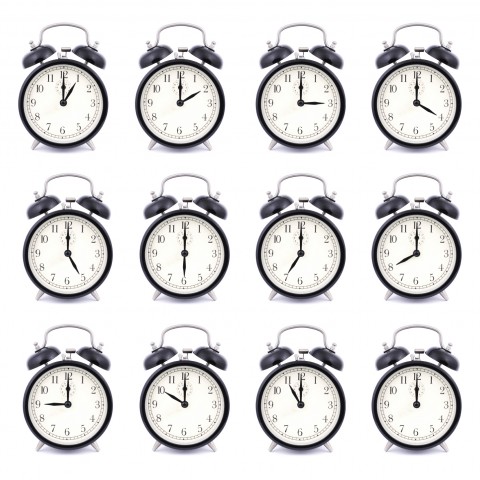
8- Half past – rưỡi
When the time is thirty minutes past the hour, in English we say “half past”. Just like the hour, the half-hour is universally used as an orientation point; some languages speak of 30 minutes before the hour (subtraction), whereas others speak of 30 minutes after the hour (addition).
9- AM – sáng
As mentioned earlier, AM is the abbreviation of the Latin ante meridiem and means before midday. Using ‘AM’ as a tag on your time simply tells people you’re speaking about a time in the morning. In some countries, morning is abbreviated to “AM” and you’ll see this on shop signs everywhere, announcing the opening hour. A typical shop sign might read something like this:
“Business hours are from 7AM to 6PM.”
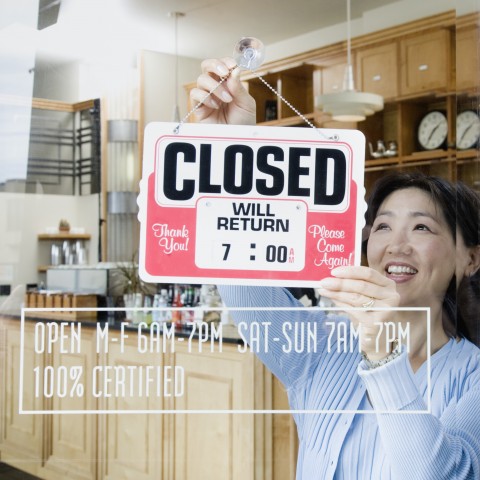
10- PM – trưa / chiều / tối
PM is the abbreviation of the Latin post meridiem and means after midday. Along with ‘AM’, you’ll usually find ‘PM’ on store signs and businesses, indicating the closing hours. It’s advisable to learn the difference between the two, since some establishments might only have one or the other on the sign. For example, a night club sign might say:
“Open from 10 PM until late.”
11- What time is it now? – Bây giờ là mấy giờ?
Here’s a very handy question you should memorize, as you can use it in any situation where you don’t have your watch or phone on you. This could be on the beach, in a club, or if you’re stuck anywhere with a flat phone battery. It happens at home, so it can happen when you’re traveling!

12- One o’clock – một giờ
One o’clock, or 1 PM, is the average lunch time for many people around the world – at least, we try to get a meal in at some point between midday and 2 PM. In terms of duration, the nations vary: Brazililans reportedly take the longest lunch breaks, averaging 48 minutes, whereas Greece reports an average break of only 19 minutes. Historically, Greeks were known for their very leisurely lunch breaks, so it just goes to show how fast the world is changing. If you’re curious about what to expect in Vietnam, try asking our online community about lunch time in Vietnamese.
13- Two o’clock – hai giờ
In his last days, Napoleon Bonaparte famously spoke of “Two o’clock in the morning courage” – meaning unprepared, spontaneous courage. He was talking about soldiers who are brave enough to tumble out of bed in an instant, straight into action, without time to think or strategize. Do you think you have what it takes? I’m pretty sure all mothers know this feeling!
14- Three o’clock – ba giờ
3 AM can be perceived as the coldest time of day and is not an hour we want to wake up, but meteorologists will tell you that the coldest time is actually half an hour after sunrise. Even though the sun is peeking over the horizon, the solar radiation is still weaker than the earth’s infrared cooling to space.
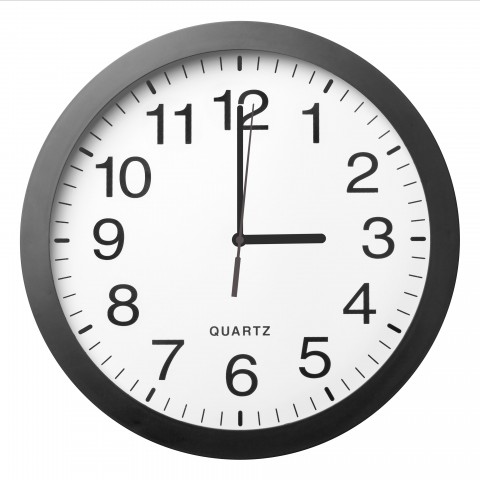
15- Four o’clock – bốn giờ
Do you know anyone who purposely gets up at 4 o’clock in the morning? As crazy as it sounds, there is something to be said for rising at 4 AM while the rest of the world sleeps. If you live on a farm, it might even be normal for you. I know that whenever I’m staying in the countryside, rising early is a lot easier, because there’s a satisfying reason to do so: watching a sunrise from a rooftop, with uninterrupted views, can’t be beat! It’s also likely that you’ll be woken by a cock crowing, or other animals waking to graze in the fresh pre-dawn air.
In the world of business, you’ll find a small group of ambitious individuals – many entrepreneurs – who swear by the 4 o’clock in the morning rise. I’m not sure I like that idea, but I’d wake up at 4 AM if it was summer and I had my car packed for a vacation!
16- Five o’clock – năm giờ
What better way to signal the transition between work and play than the clock hands striking 5 o’clock? It’s the hour most working people look forward to each day – at least, those who get to stop working at 5 PM. Meanwhile, millions of retired folks are taking out the wine glasses, as 5 PM is widely accepted as an appropriate time to pour the first glass. I don’t know how traditional your families are, but for as long as I’ve been alive, my grandparents have counted down the milliseconds to five o’clock, and the hour is announced with glee.

17- Six o’clock – sáu giờ
This is the time many working people and school kids wake up in the morning. In many parts of the world, 6 o’clock is also a good time to watch the sunrise, go for a run or hit the hiking trails.
18- Seven o’clock – bảy giờ
Health gurus will tell you that 7 o’clock in the morning is the best time to eat your first meal of the day, and 7 o’clock in the evening is the time you should eat your last meal. I’ve tried that and I agree, but it’s not always easy!
19- Eight o’clock – tám giờ
8 o’clock in the morning is the time that most businesses open around the world, and the time most kids are in their first lesson at school – still full of energy and willing to participate. Interestingly, it’s also the time most babies are born in the world! In the evening, 8 o’clock is many young children’s bedtime and the time for parents to watch the evening news.

20- Nine o’clock – chín giờ
It’s good to occasionally sleep late on a weekend and for me, this means waking up at 9 AM. If you’re traveling in Vietnam and staying at a hotel, planning to sleep late means politely requesting to not be woken up by room service.
21- Ten o’clock – mười giờ
10 o’clock in the morning is a popular time to conduct business meetings, and for first break time at schools. We’re usually wide awake and well into our day by then. But what about the same hour at night? Modern people are often still awake and watching TV at 10 PM, but this isn’t exactly good for us. Experts say that the deepest and most regenerative sleep occurs between 10 PM and 2 AM, so we should already be sound asleep by ten o’clock.
In advertising, have you ever noticed that the hands of the clock usually point to 10:10? Have a look next time you see a watch on a billboard or magazine. The reason? Aesthetics. Somehow, the human brain finds the symmetry pleasing. When the clock hands are at ten and two, they create a ‘smiley’ face and don’t cover any key details, like a logo, on the clock face.
22- Eleven o’clock – mười một giờ
When I see this time written in words, it makes me think of the hilarious Academy Award-winning very short film, “The Eleven O’Clock”, in which the delusional patient of a psychiatrist believes that he is actually the doctor.
Then there’s the tradition of ‘elevenses’ – tea time at eleven o’clock in the morning. Strongly ingrained in British culture, elevenses is typically a serving of hot tea or coffee with scones or pastries on the side. It’s a great way to stave off hunger pangs before lunch time arrives. In fact, if you were a hobbit, ‘Elevenses’ would be your third meal of the day!
23- Twelve o’clock – mười hai giờ
Twelve o’clock in the daytime is considered midday, when the sun is at its zenith and the temperature reaches its highest for that day; it’s written as 12 noon or 12 PM. In most parts of the world, though, this doesn’t happen at precisely 12 PM. ‘Solar noon’ is the time when the sun is actually at its highest point in the sky. The local or clock time of solar noon depends on the longitude and date. If it’s summertime, it’s advisable to stay in the shade during this hour – or at least wear good quality sunblock.
Midnight is the other ‘twelve o’clock’, of course. Midnight is written as 12 AM and is technically the first minute of the morning. On the 24-hour clock, midnight is written as 00:00.

2. How to Tell the Time in Vietnamese

Using a clock to read the time in Vietnam is going to be the same as in your own country, since you’re dealing with numbers and not words. You’ll know the time in your head and be able to say it in English, but will you be able to say it out loud in Vietnamese?
The first step to saying the time in Vietnamese is knowing your numbers. How are you doing with that? If you can count to twelve in Vietnamese, you’re halfway there! We’ve already covered the phrases you’ll need to say the exact hour, as in “five o’clock”, as well as how to say “half past”. What remains is the more specific phrases to describe what the minute hand is doing.
In everyday speech, it’s common to say the minutes past or before the hour. Often we round the minutes off to the nearest five.
Then, there’s the 24-hour clock. Also known as ‘military time’, the 24-hour clock is used in most countries and, as such, is useful to understand. You’ll find that even in places where the 12-hour clock is standard, certain people will speak in military time or use a combination of the two. No doubt you’ve also noticed that in written time, the 24-hour clock is commonly used. One of the most prominent places you’ll have seen this is on airport flight schedules.

Knowing how to tell military time in Vietnamese is really not complicated if you know your numbers up to twenty-four. One advantage of using the 24-hour clock in Vietnamese, is there’s no chance of confusing AM and PM.
Once you know how to say the time, it will be pretty easy to also write the time in Vietnamese. You’re already learning what the different hours and minutes look and sound like, so give yourself some writing practice of the same.
3. Conclusion
Now that you understand the vocabulary for telling time in Vietnamese, the best thing you can do to really lock it down is to just practice saying Vietnamese time daily. Start by replacing English with Vietnamese whenever you need to say the time; in fact, do this whenever you look at your watch. Say the time to yourself in Vietnamese and it will become a habit. When learning a new language, the phrases you use habitually are the ones your brain will acquire. It feels amazing when that turning point comes!
To help yourself gain confidence, why don’t you make use of our various apps, downloadable for iPhone and iPad, as well as Android? Choose what works best for you. In addition, we have so many free resources available to supplement your learning, that you simply can’t go wrong. Some of these are:
- Free lessons on iTunes
- A free mini lesson every day with the Innovative Language Calendar.
- Free audio books for lessons on the go.
If you prefer watching your lessons on video, check out our YouTube channel – there are hundreds of videos to browse. For those of you with Roku, we also have a TV channel you can watch.
Well, it’s time for me to say goodbye and for you to practice saying the time in Vietnamese. Look at the nearest clock and try to say the exact time, down to the seconds. See you again soon at VietnamesePod101!












